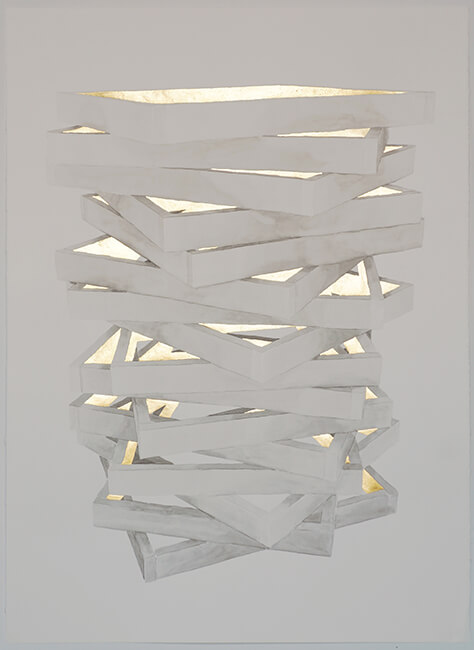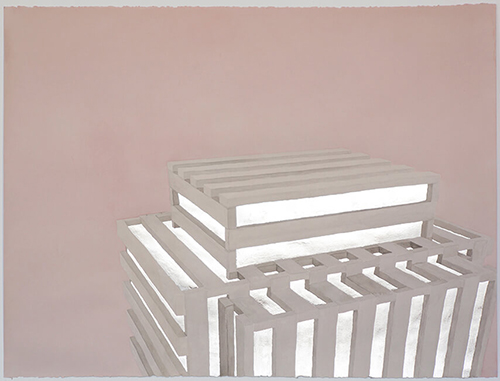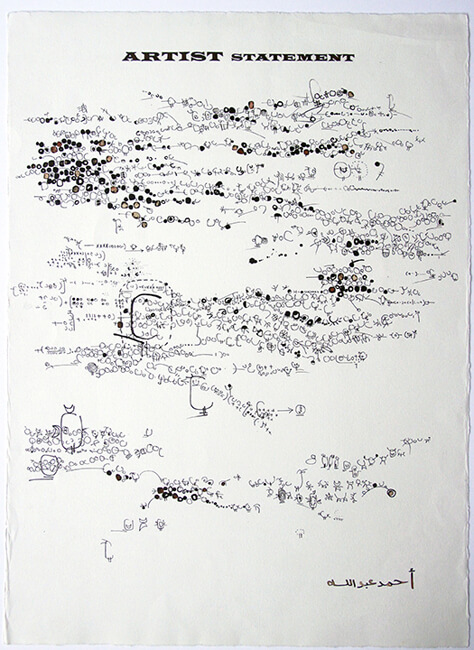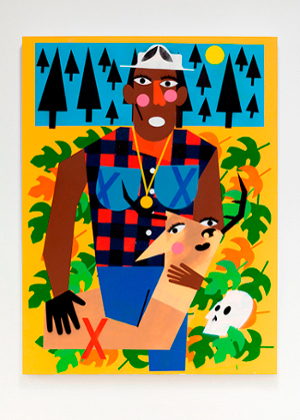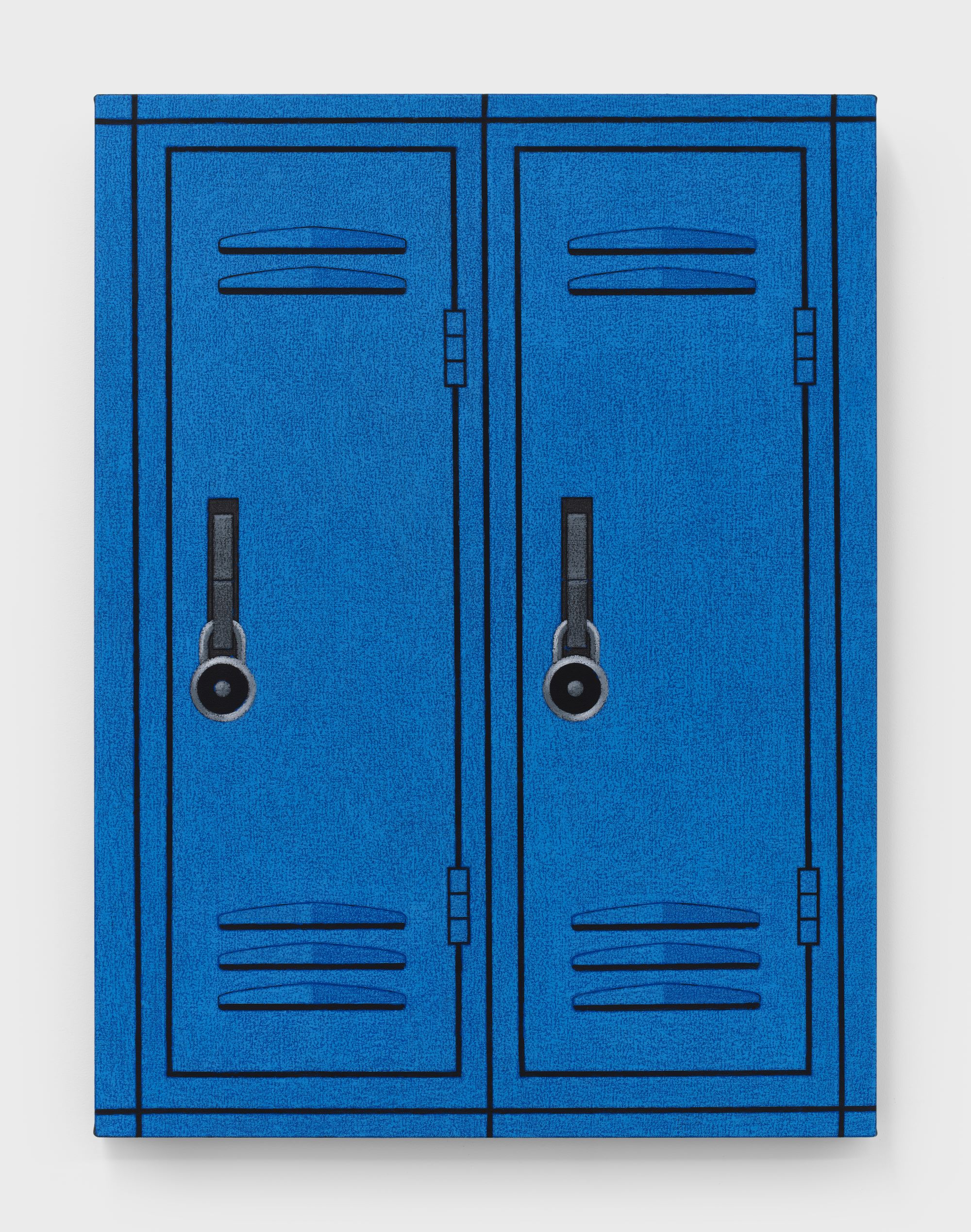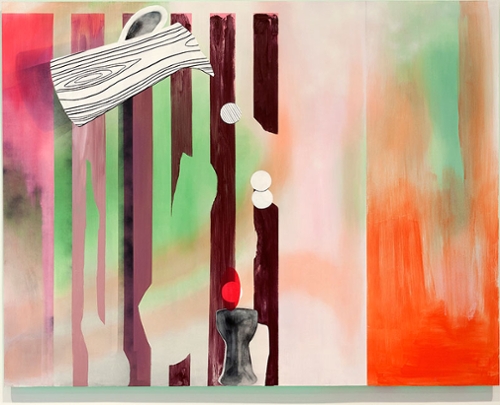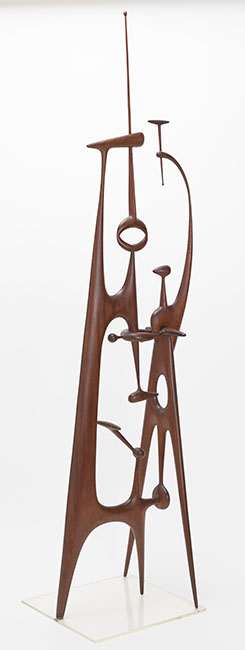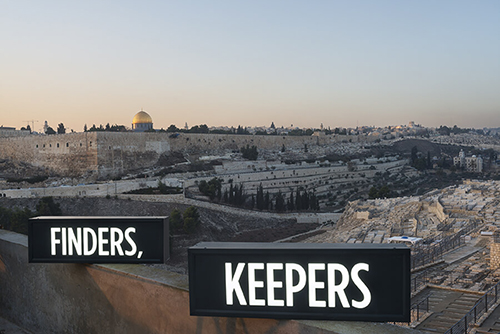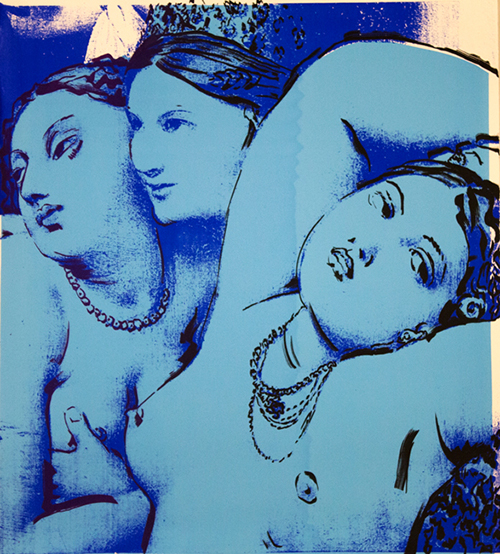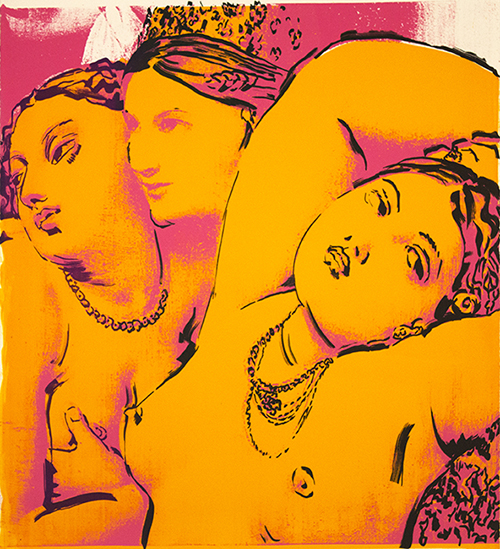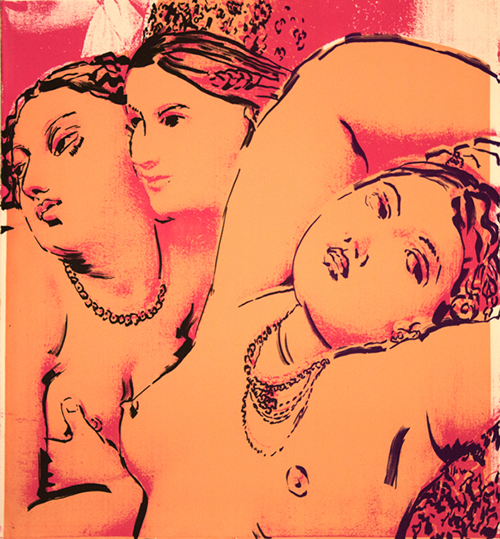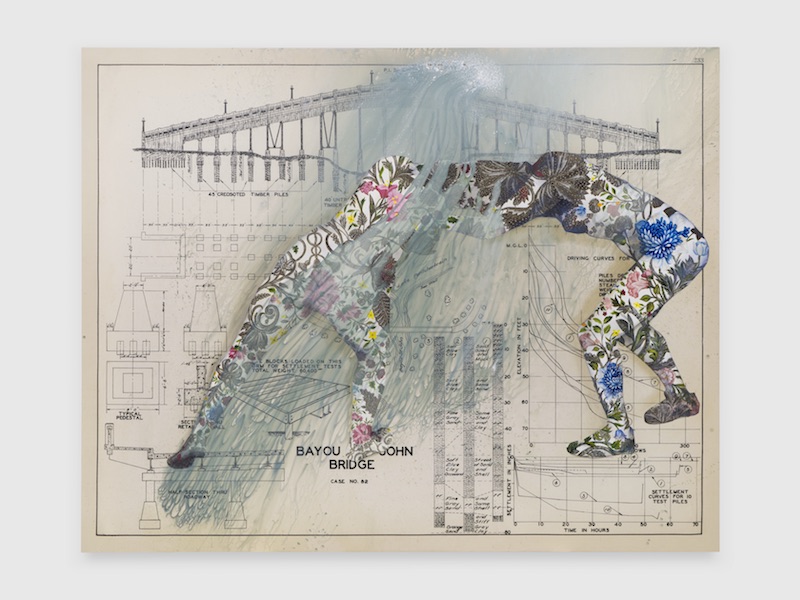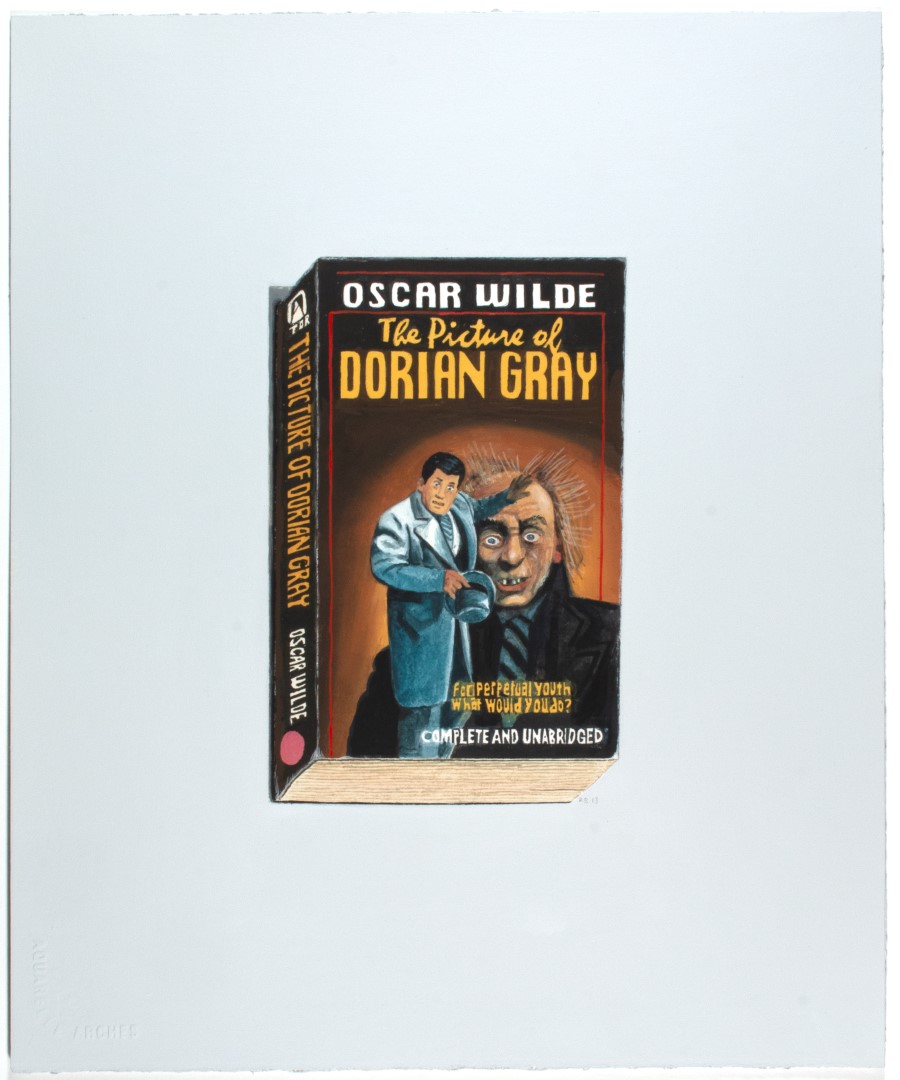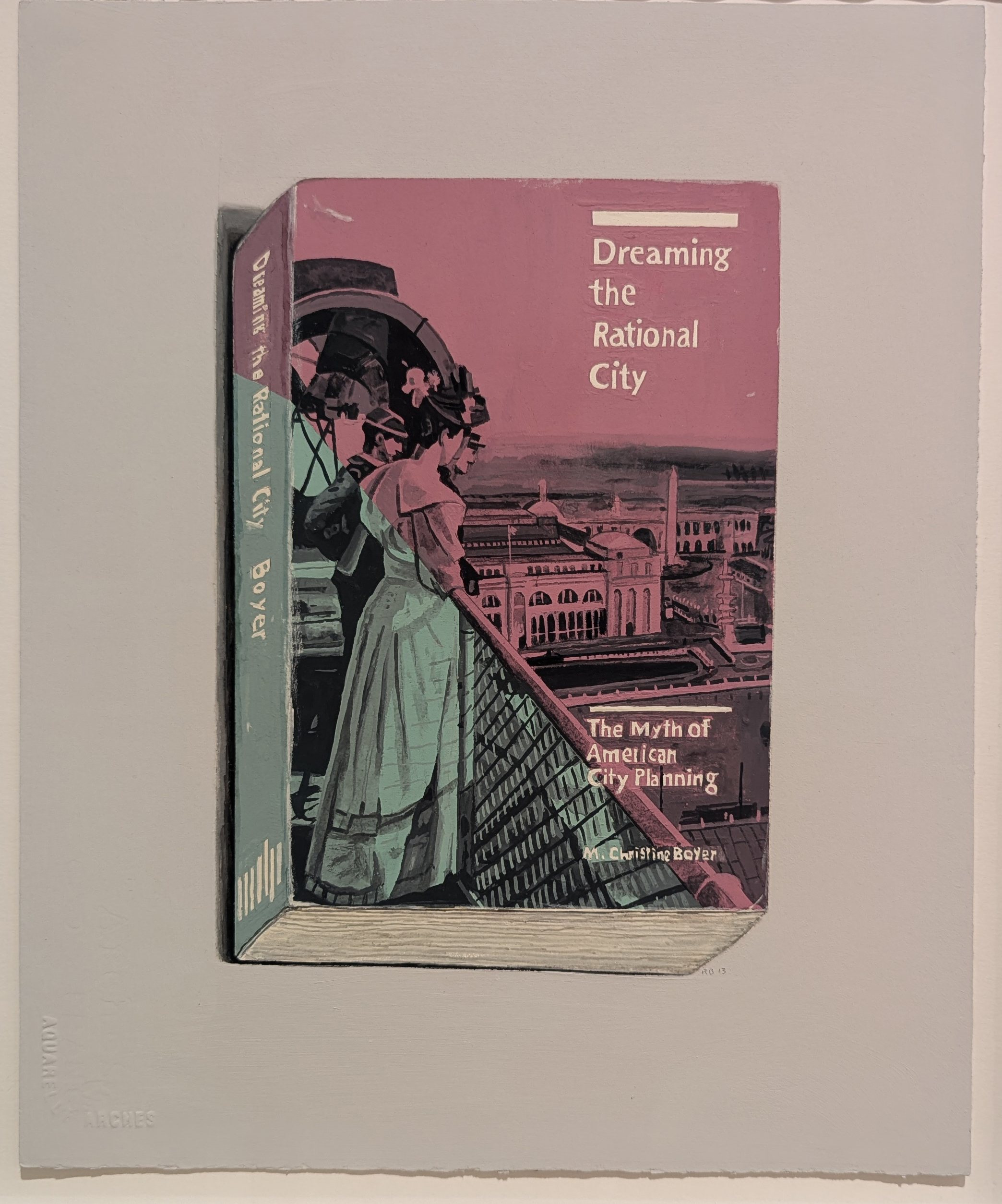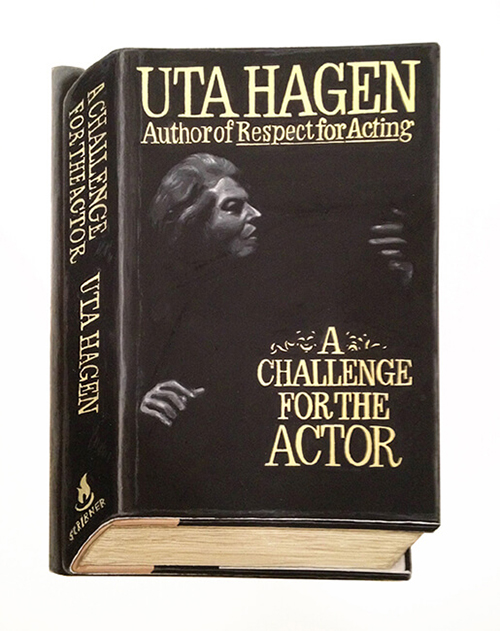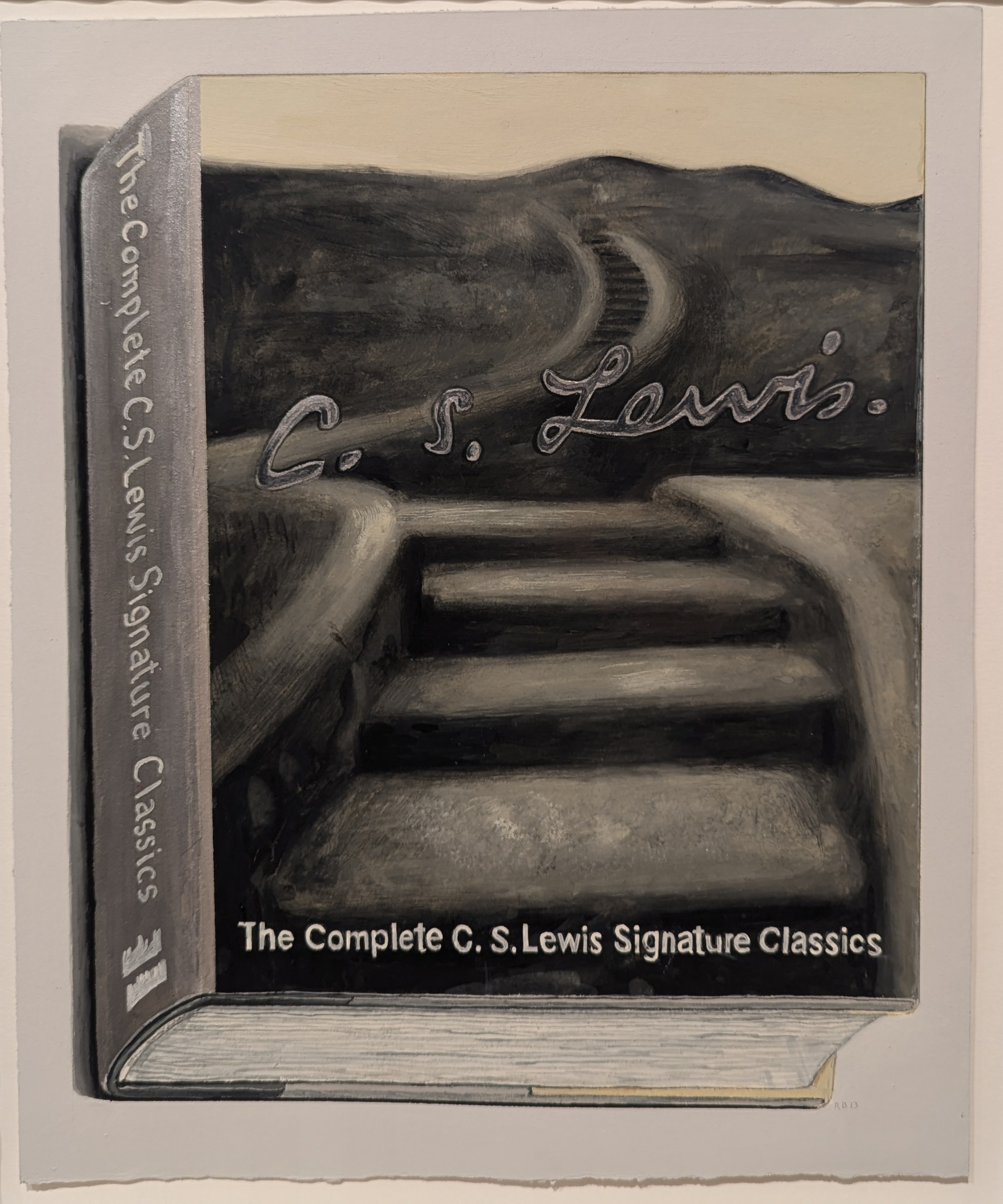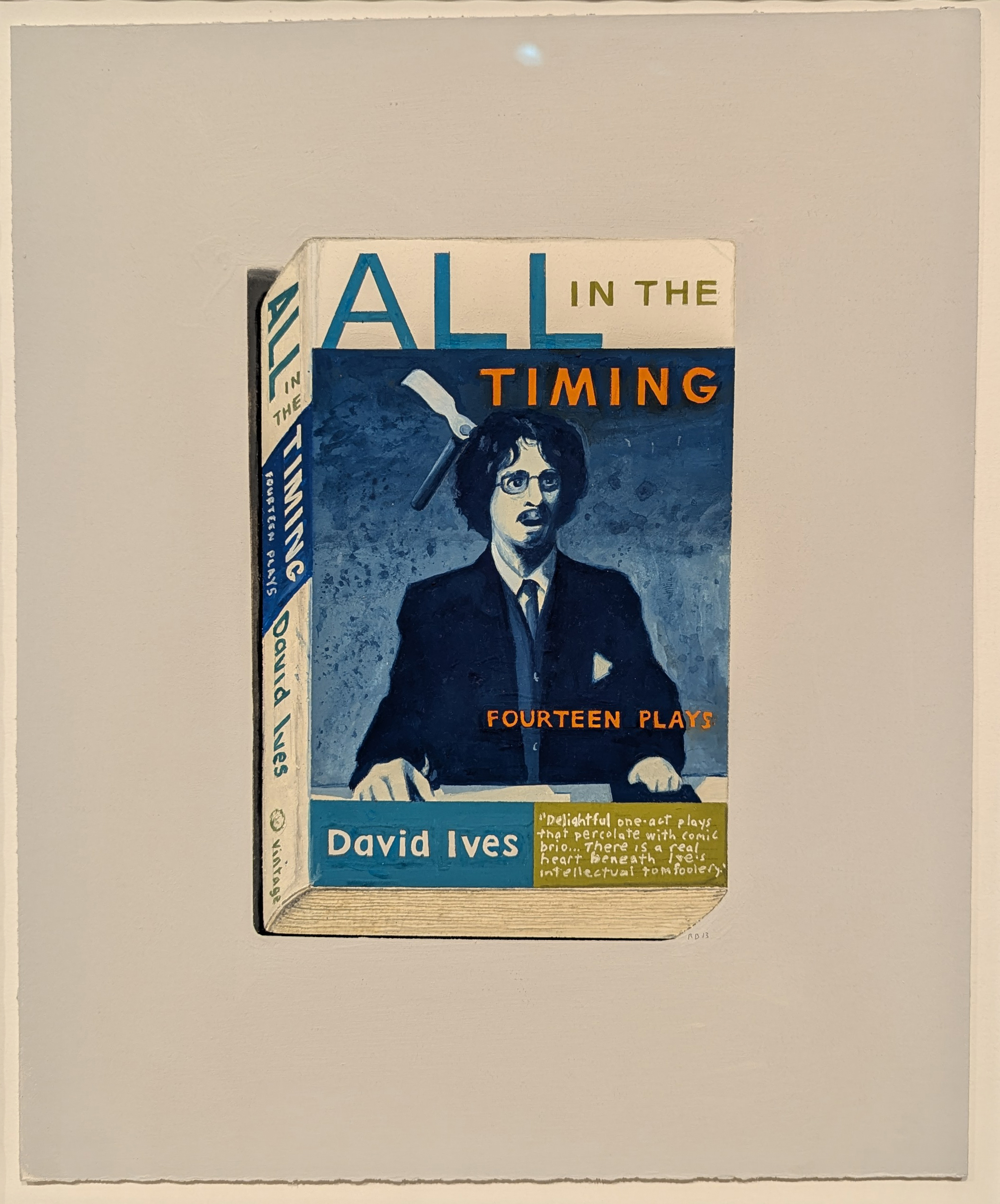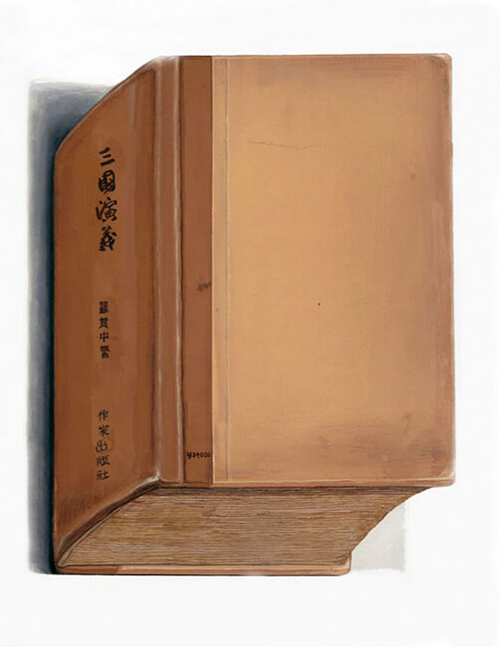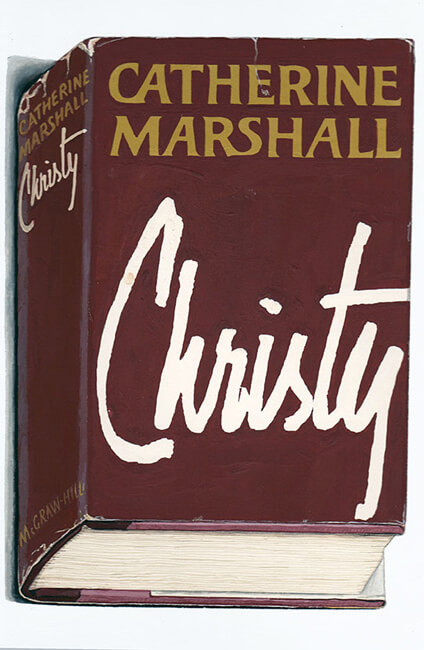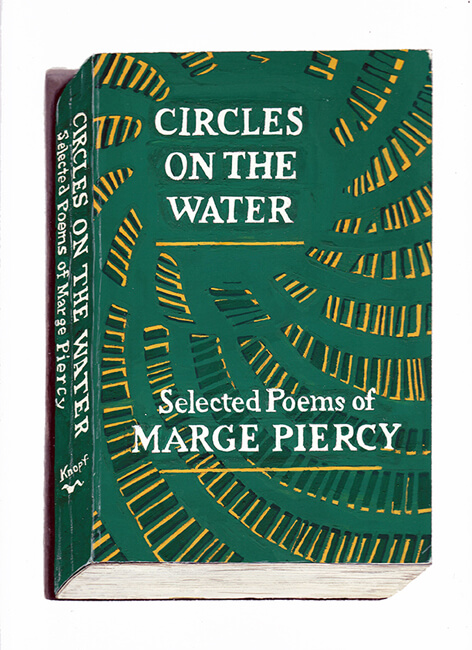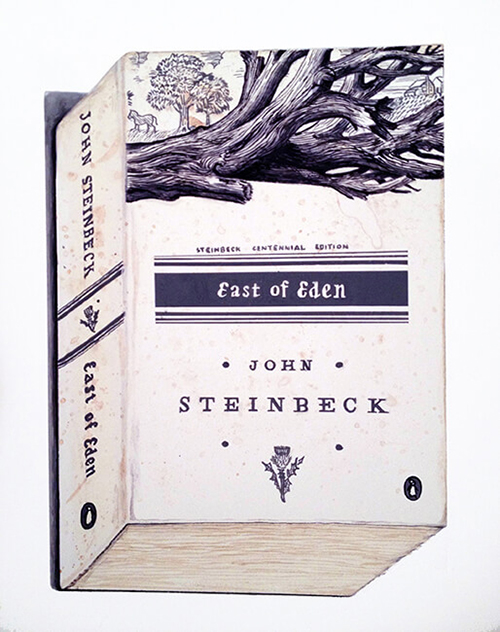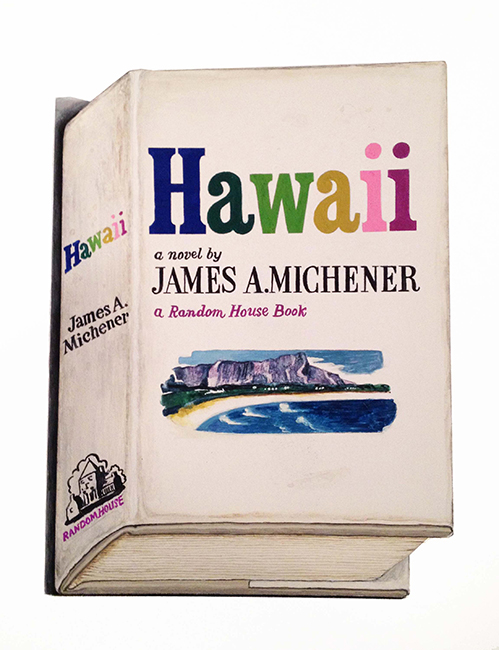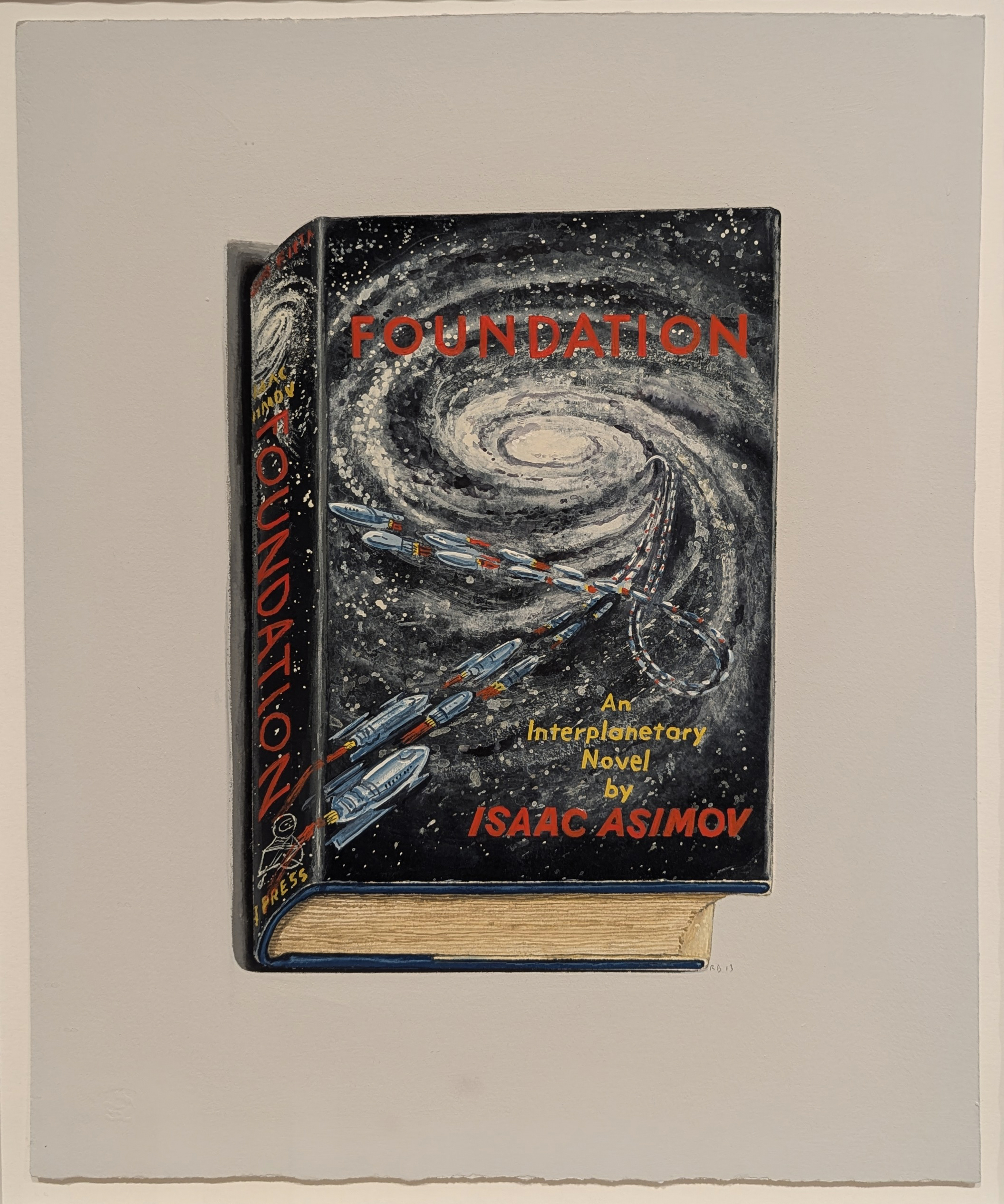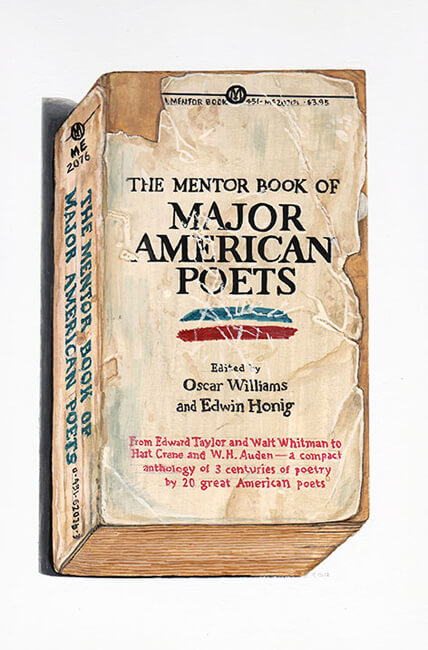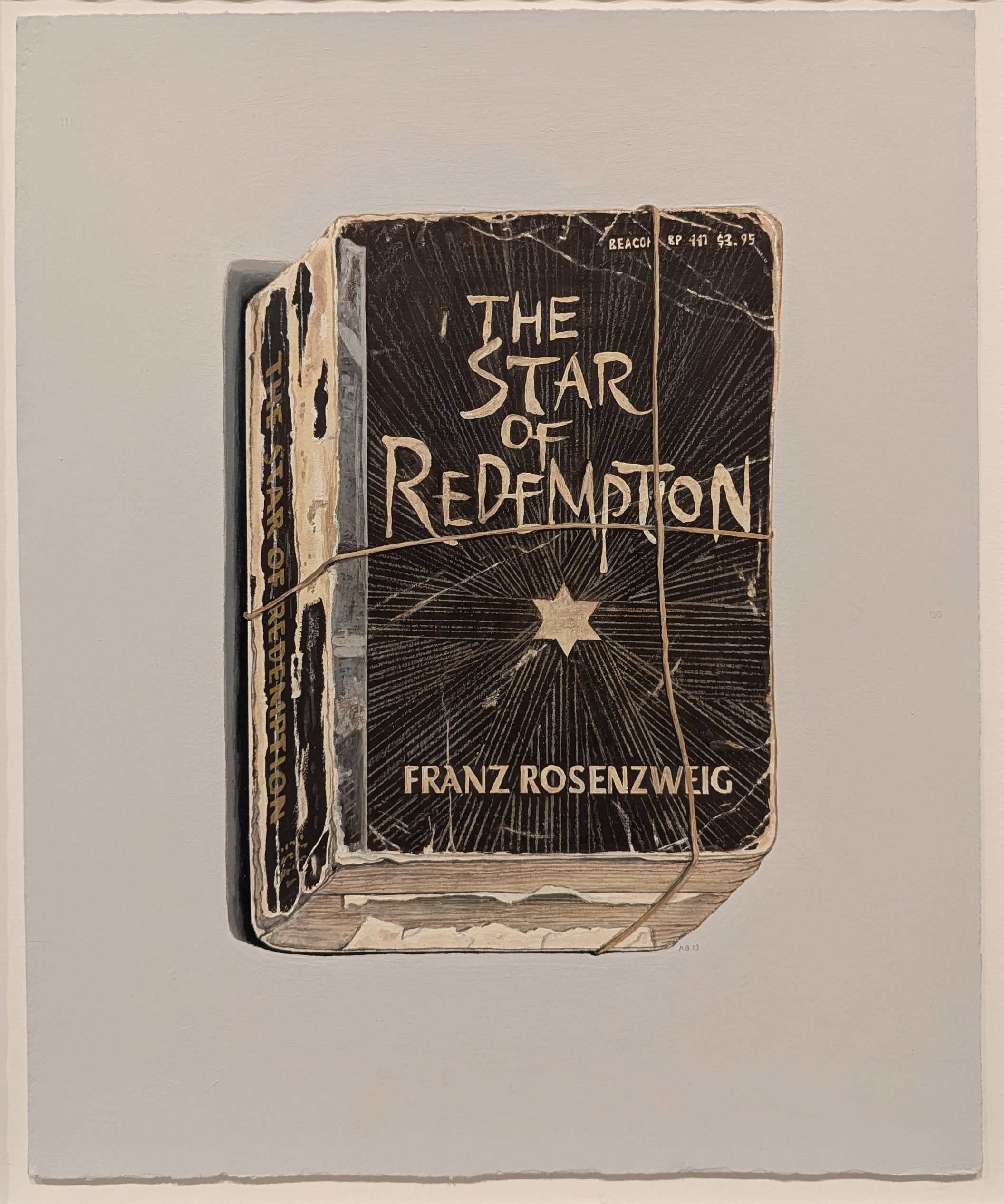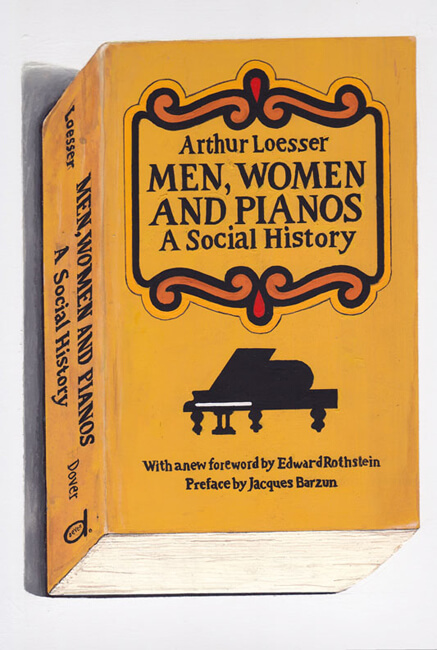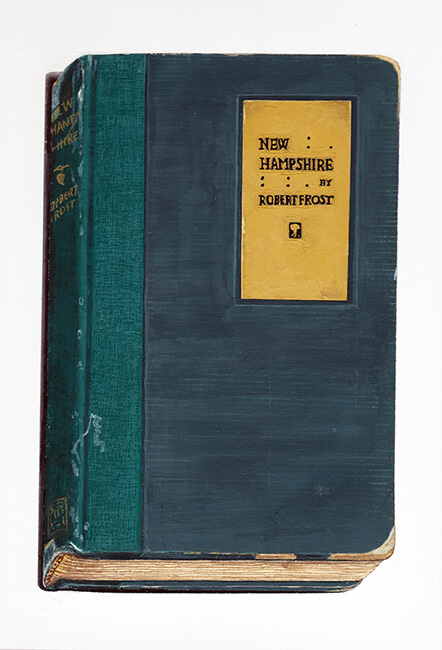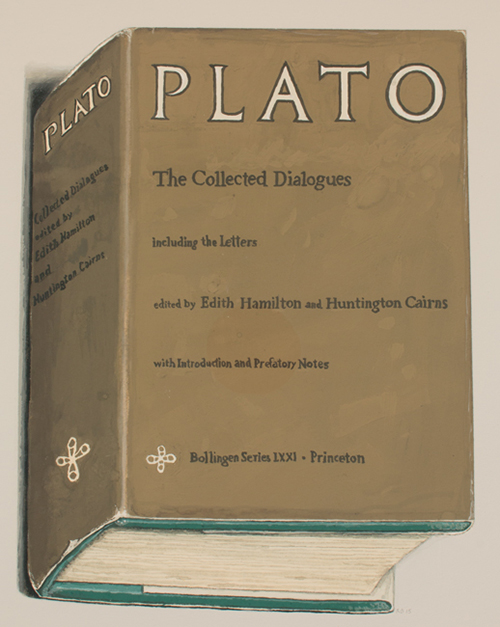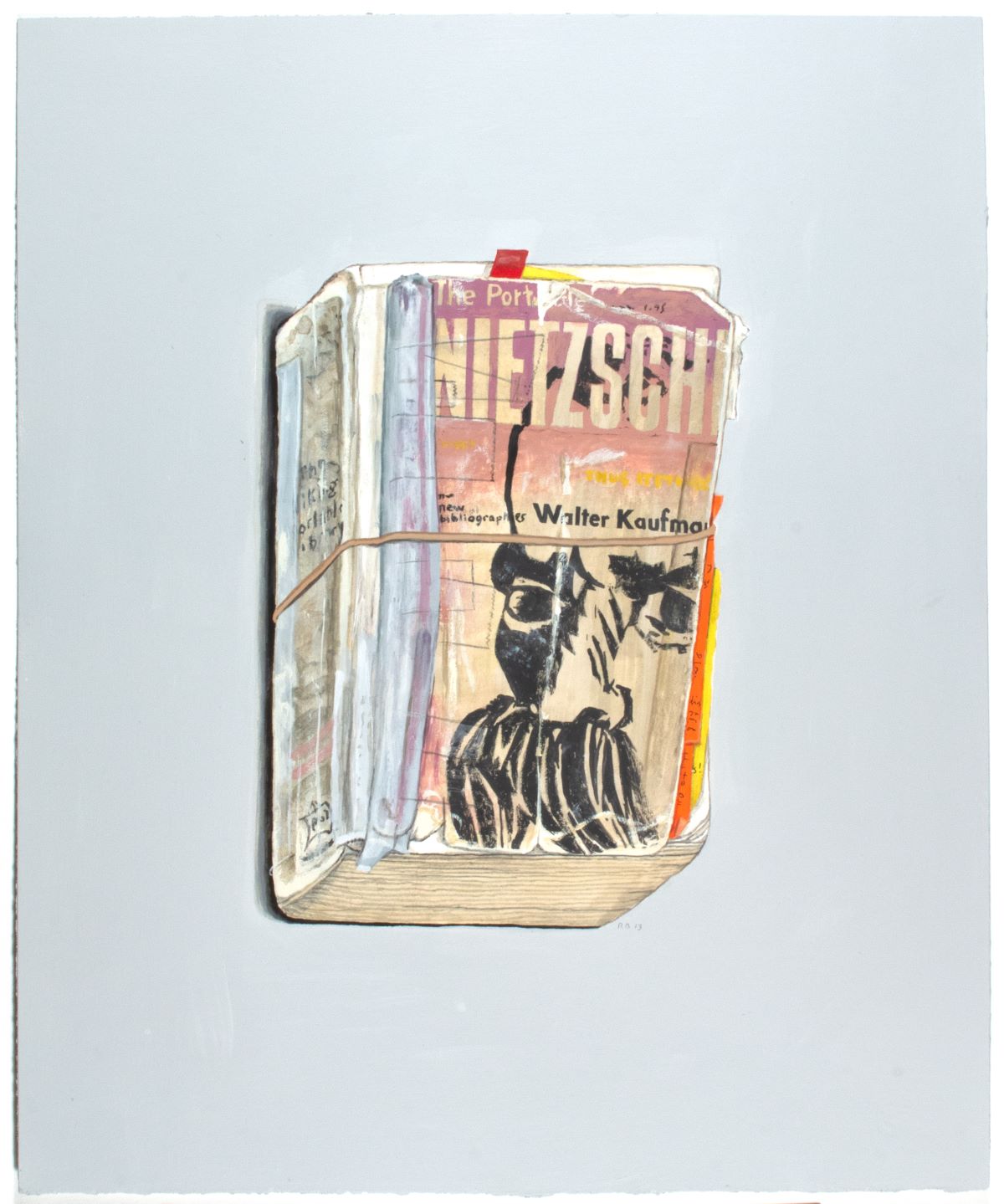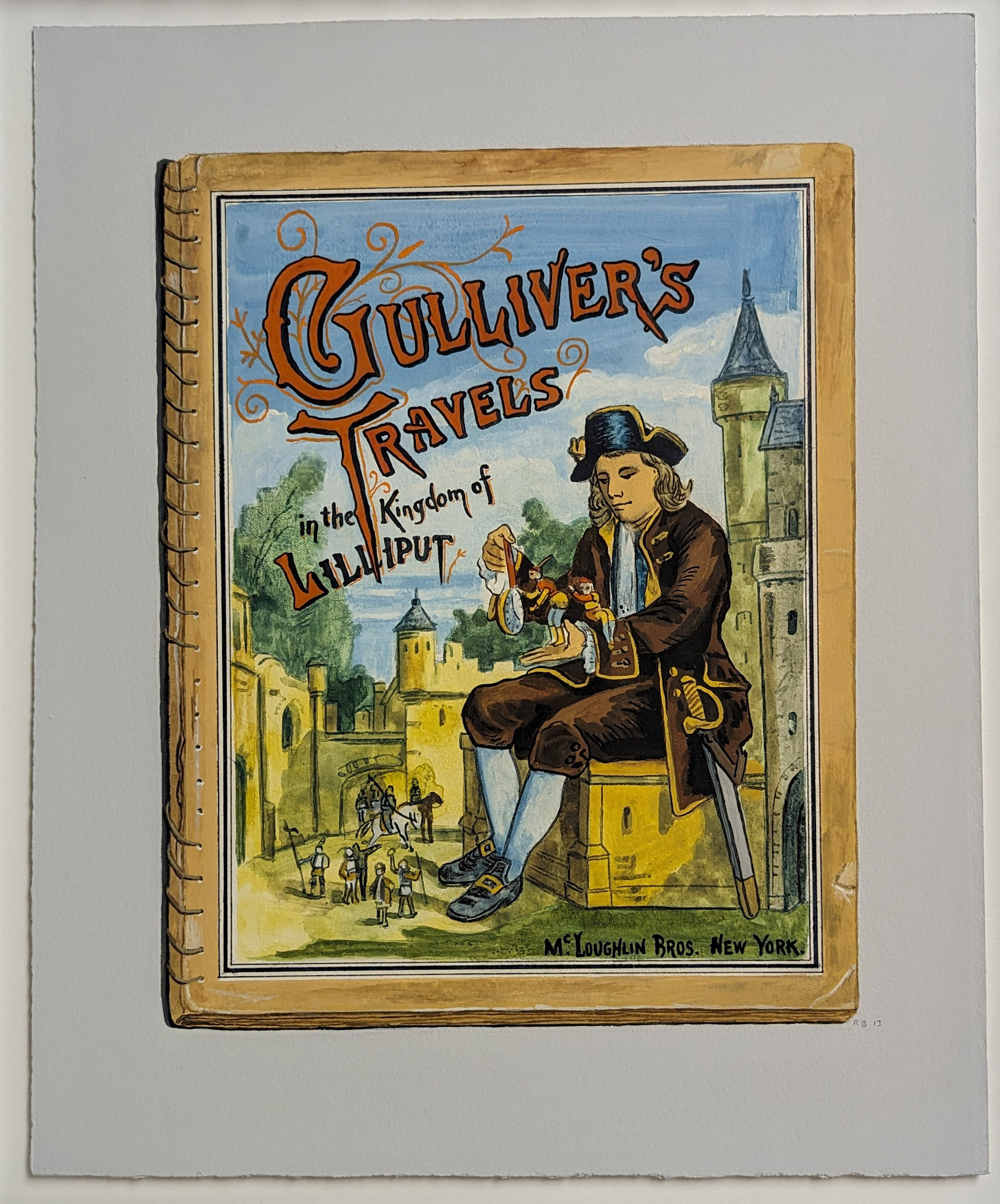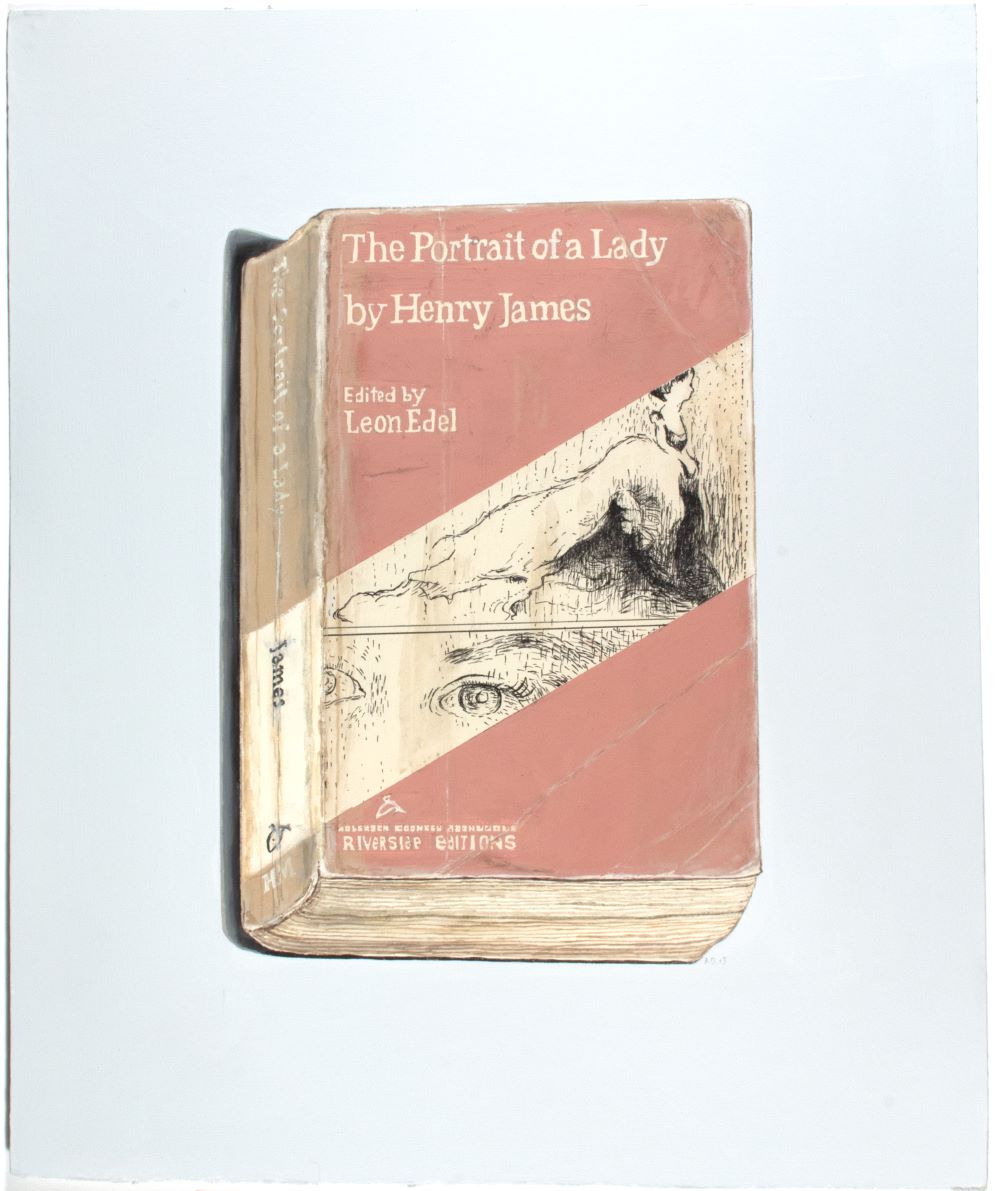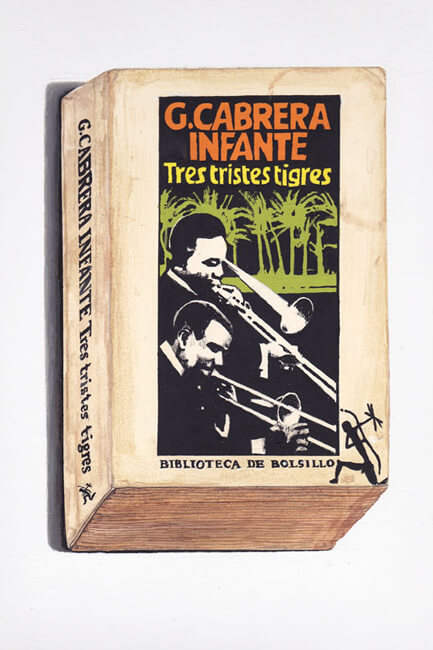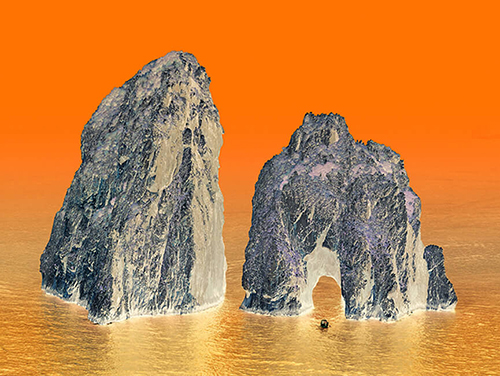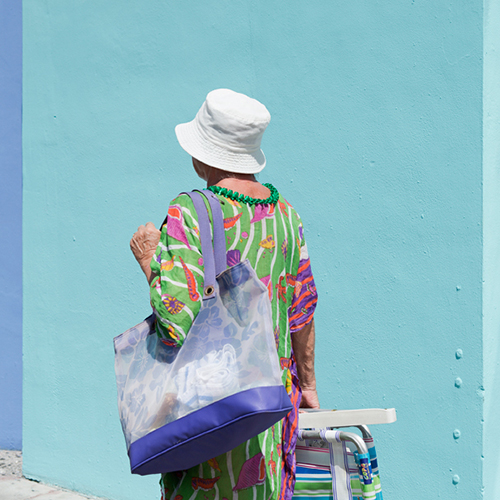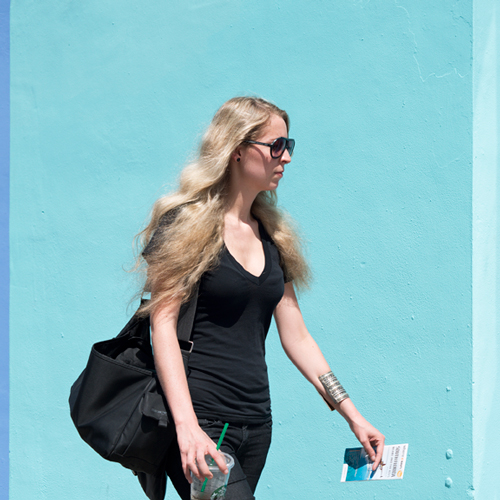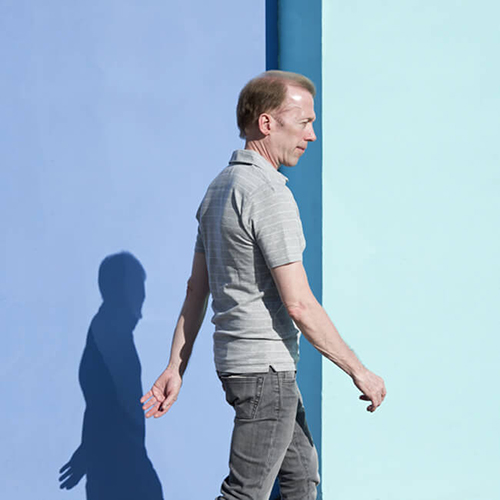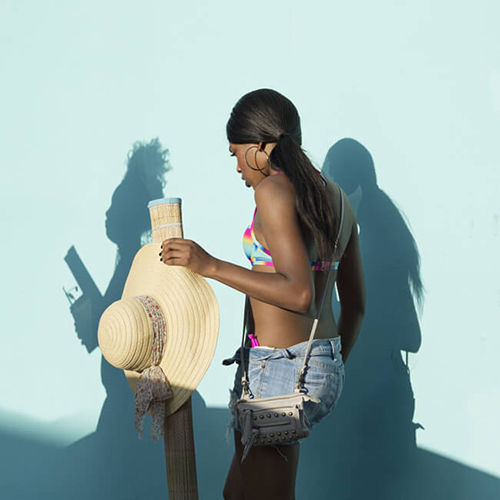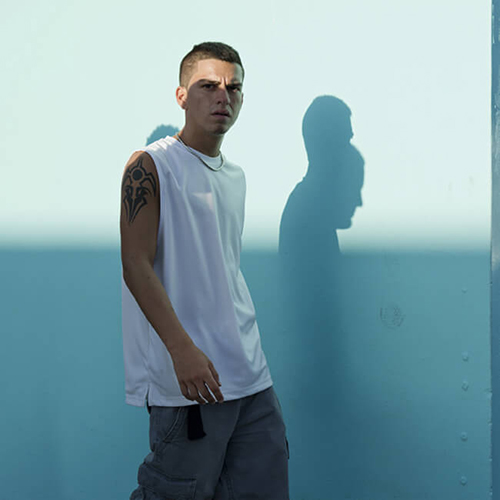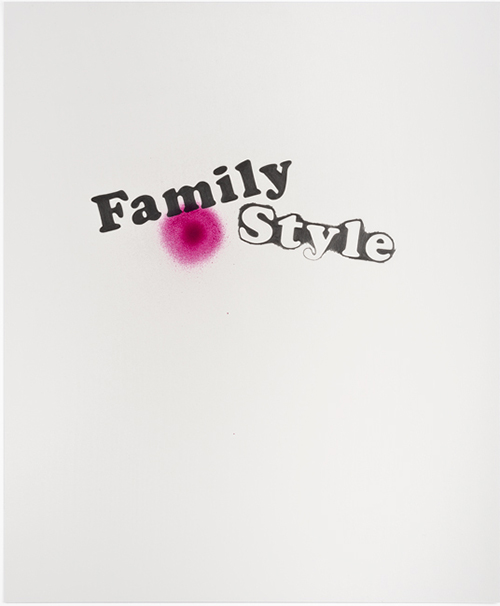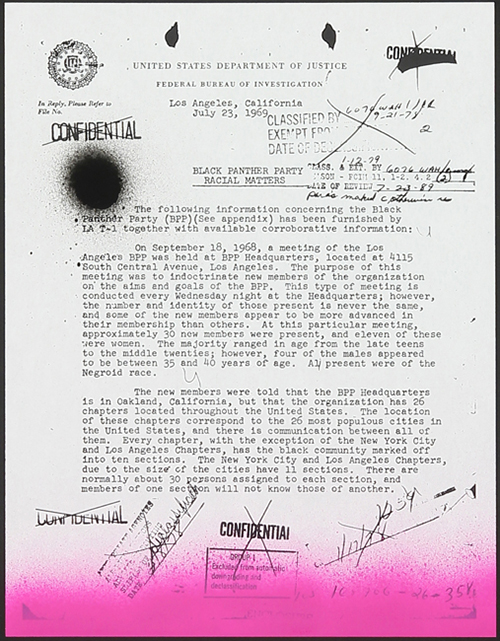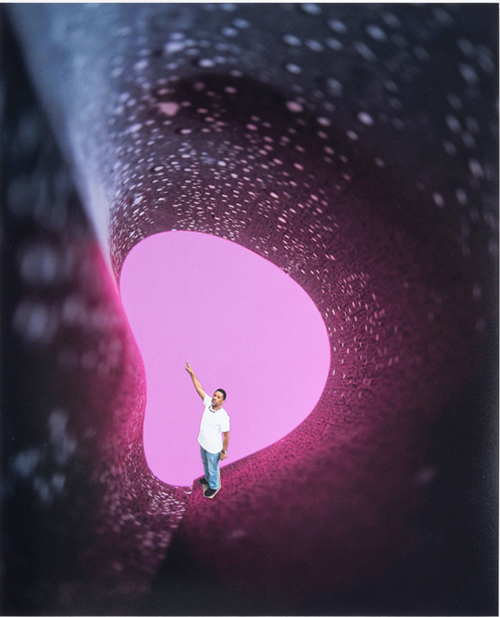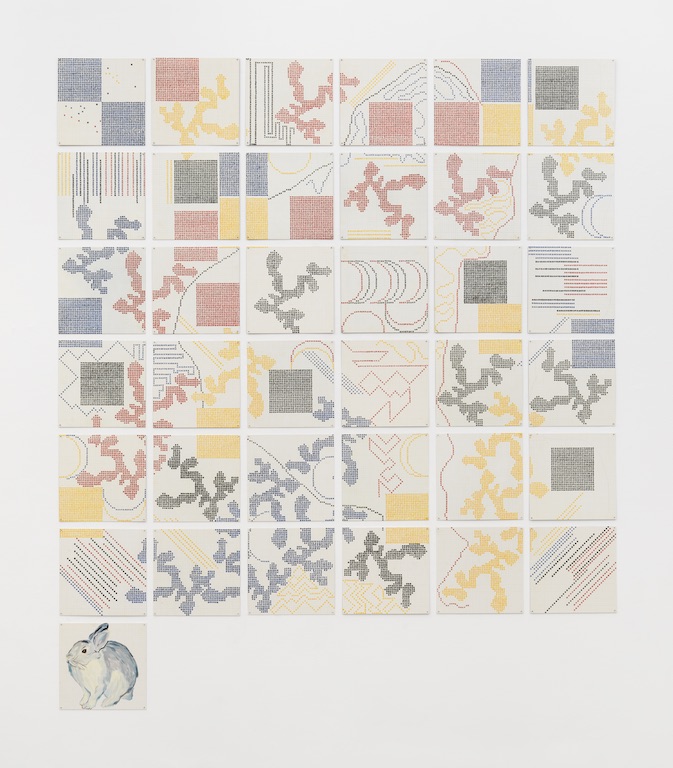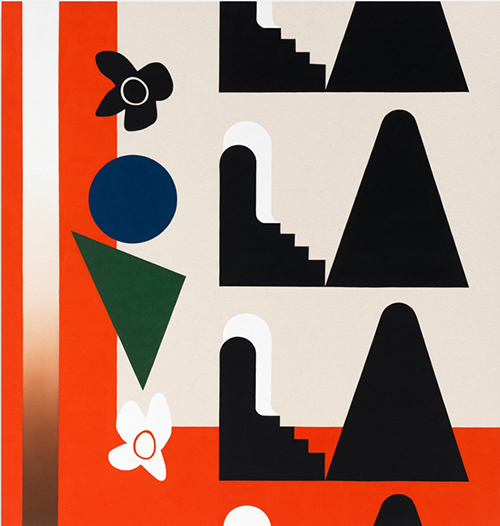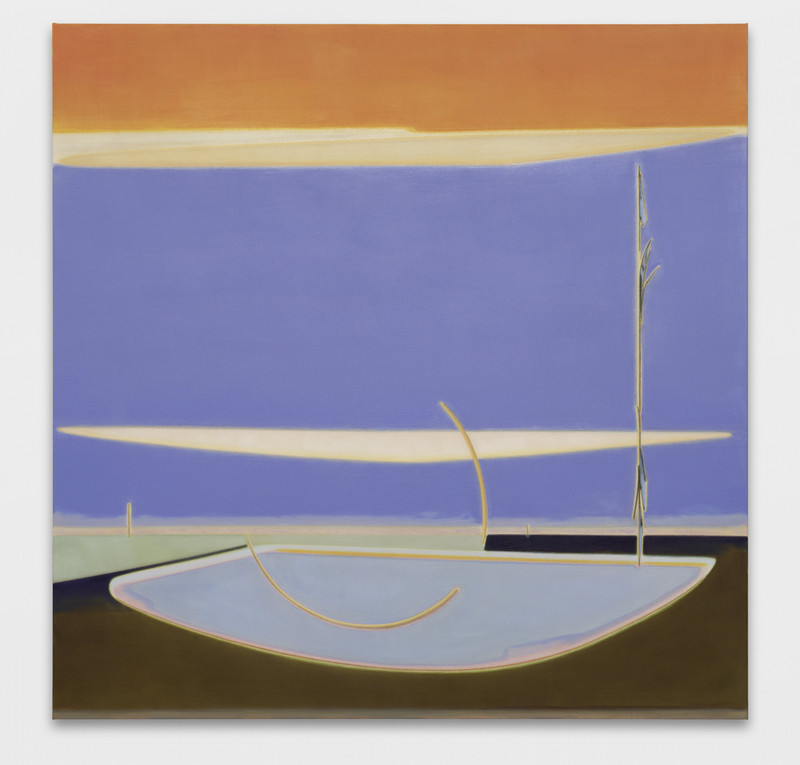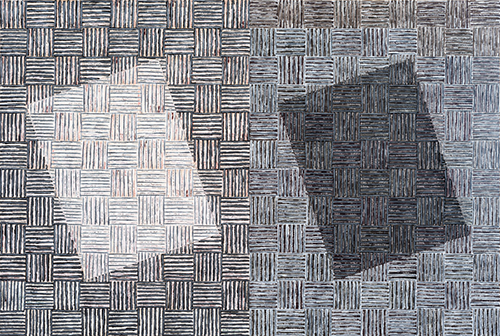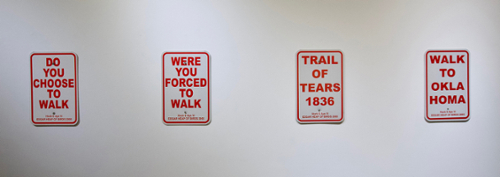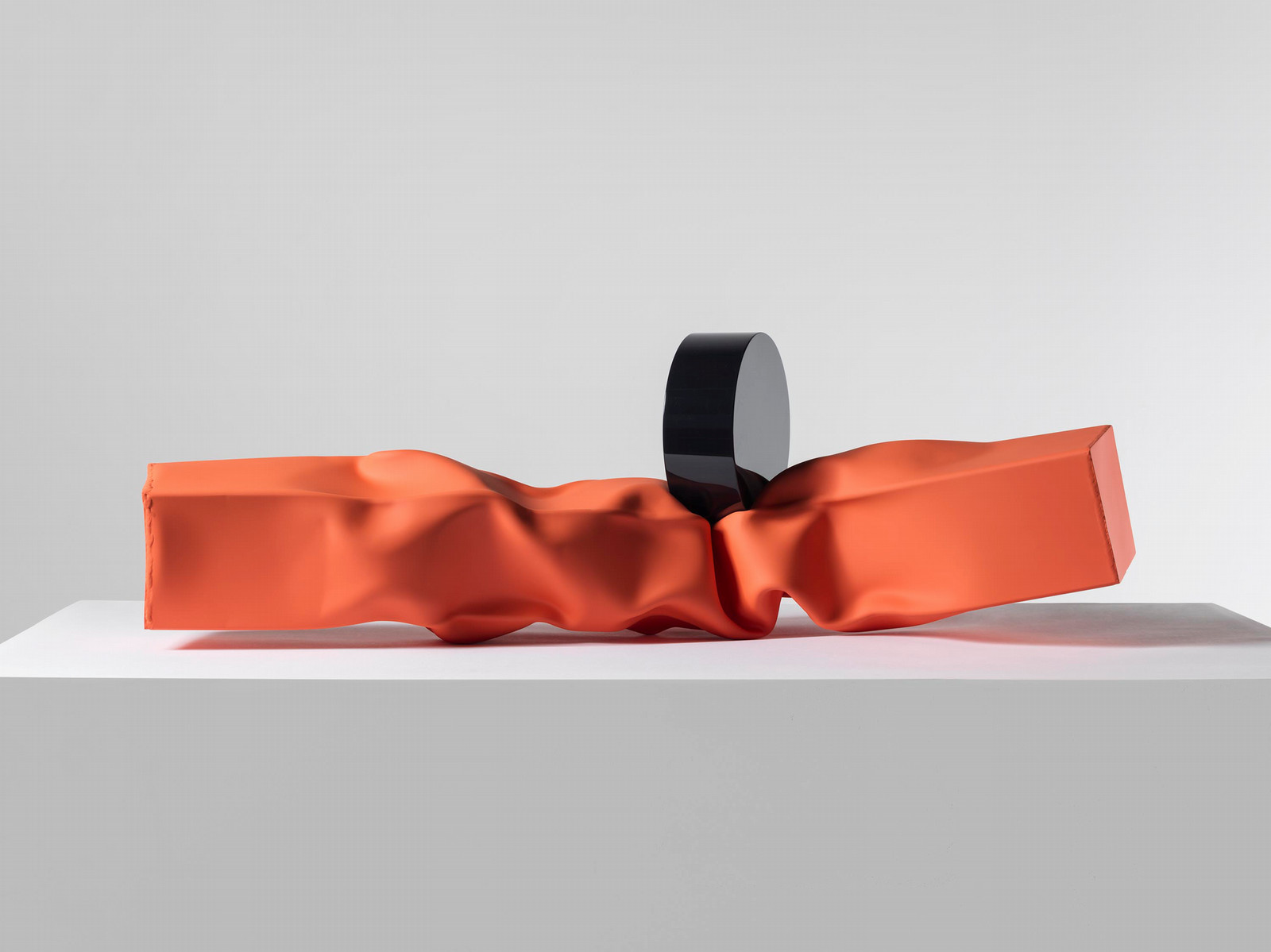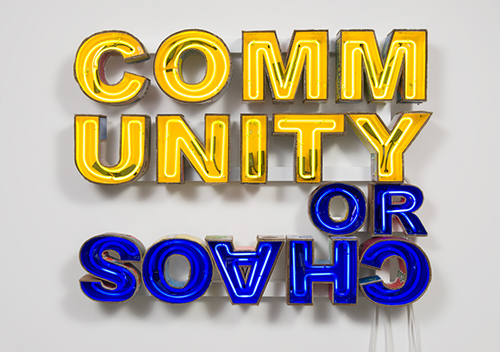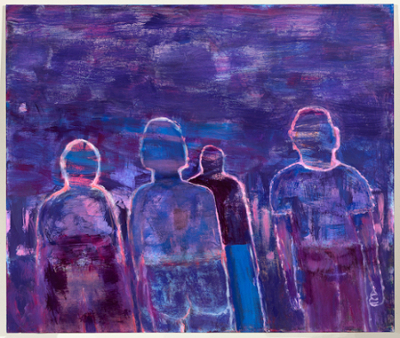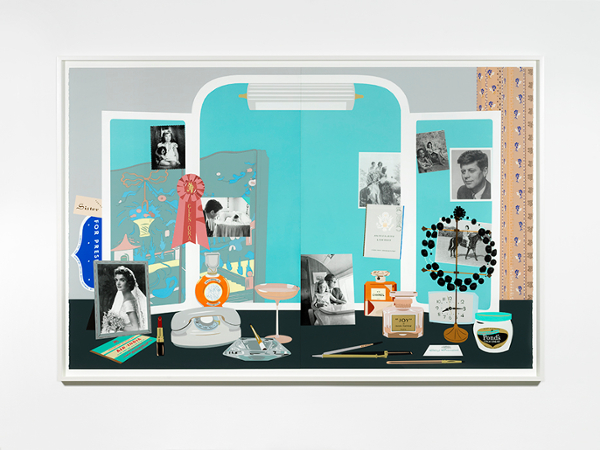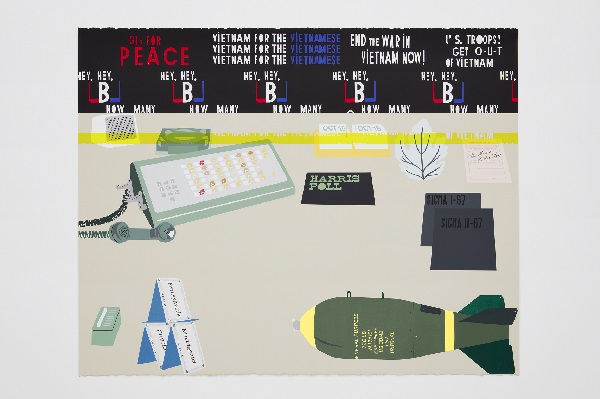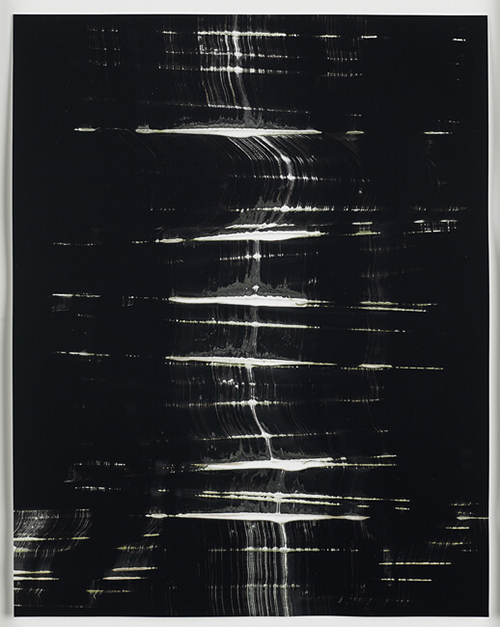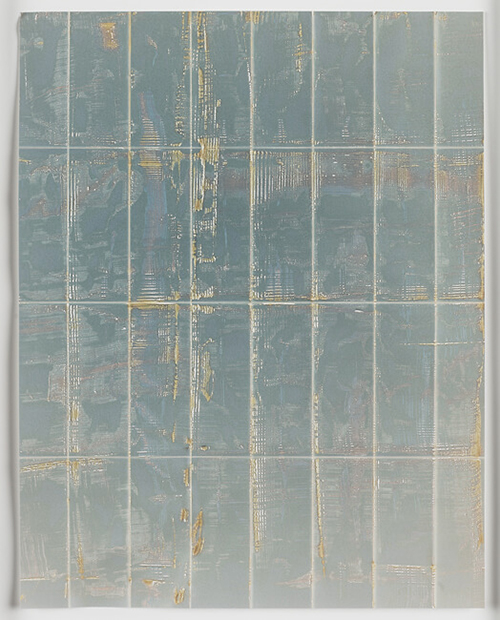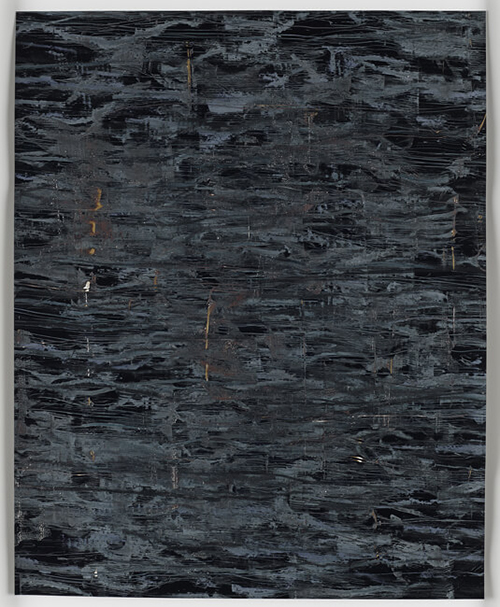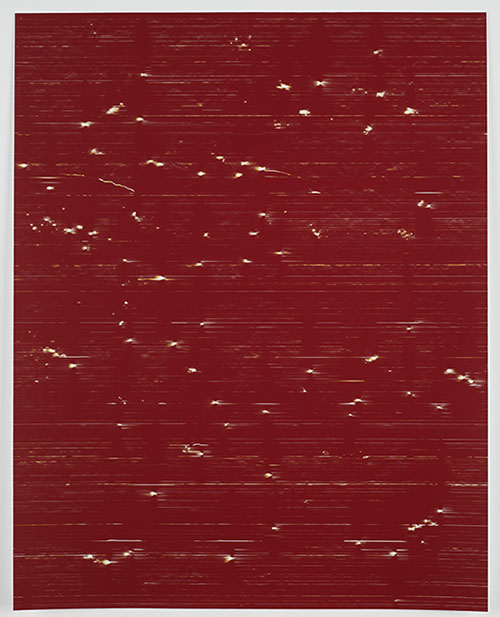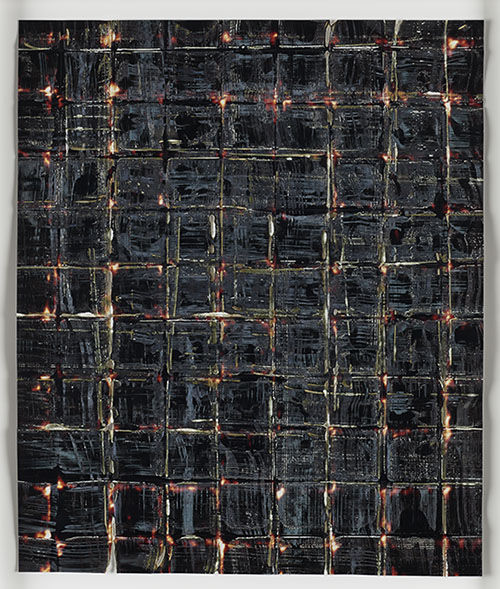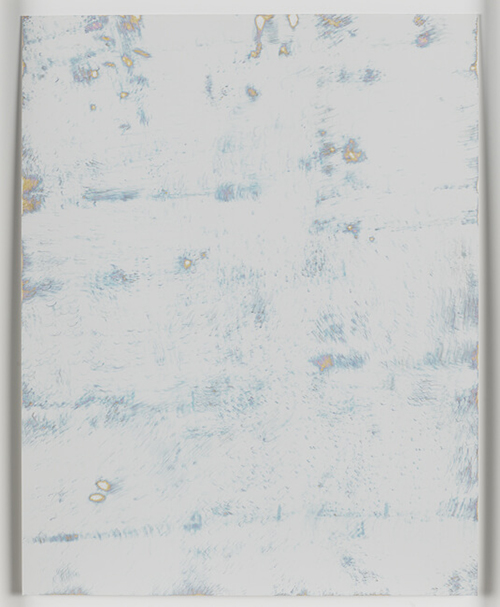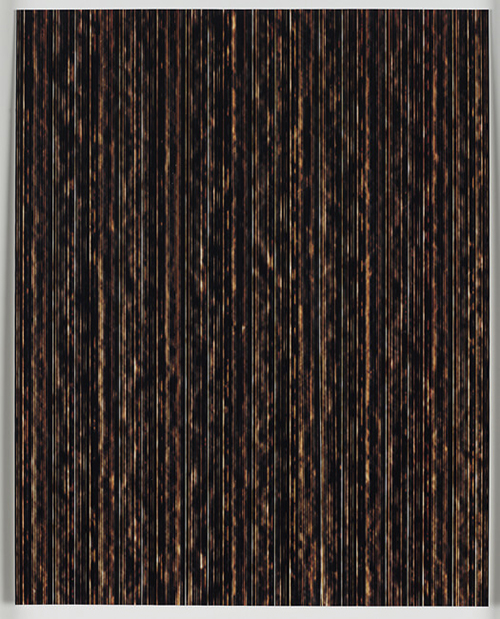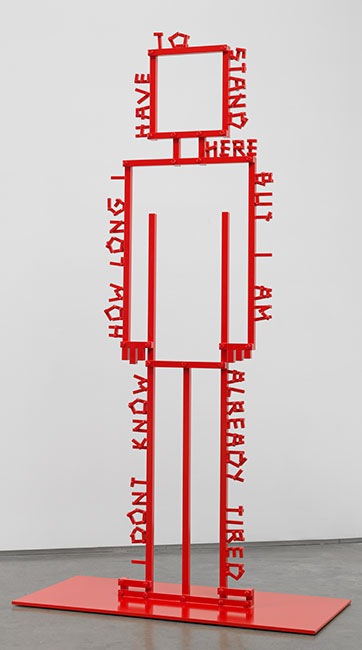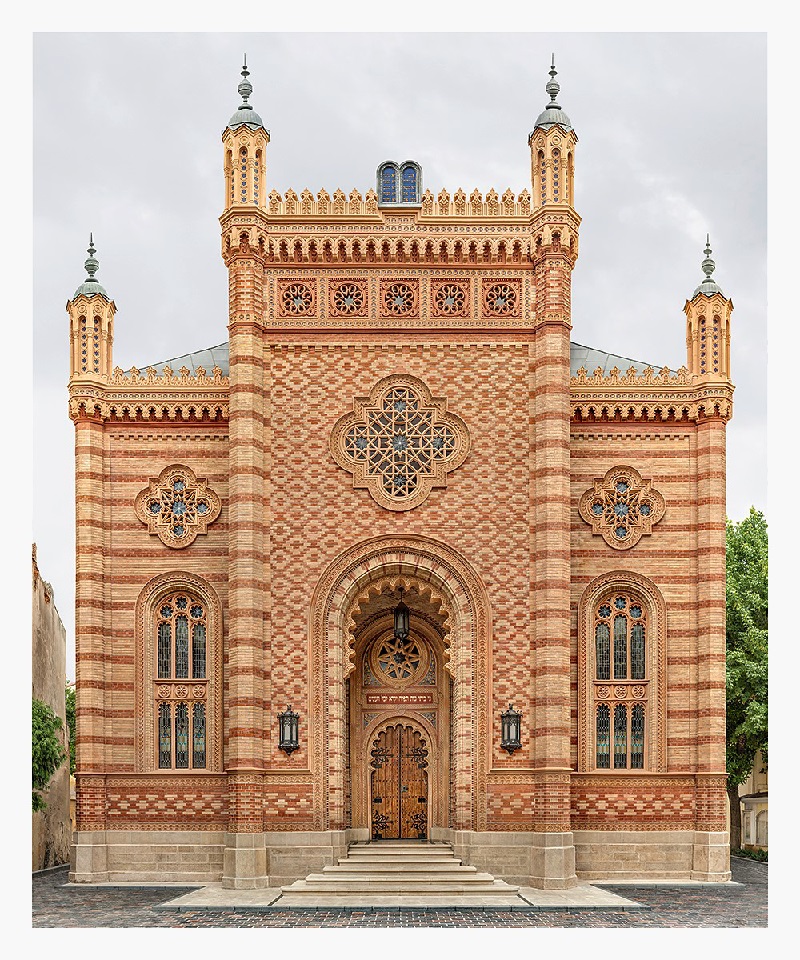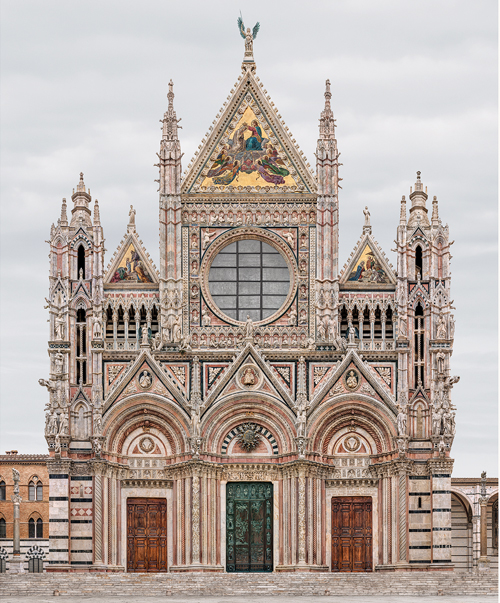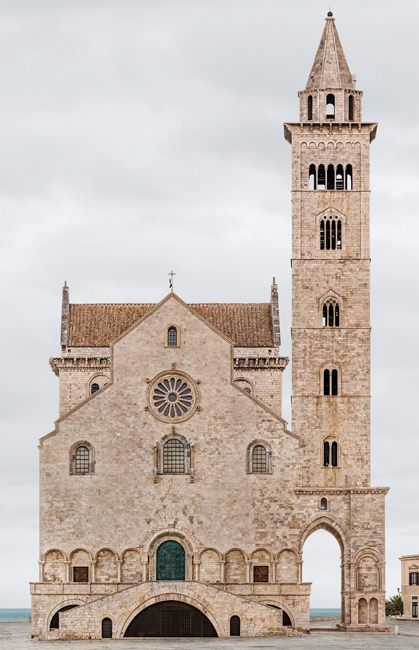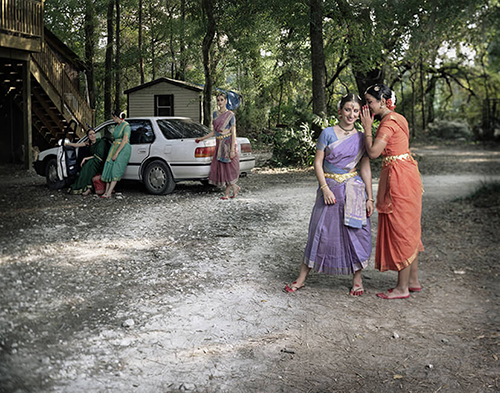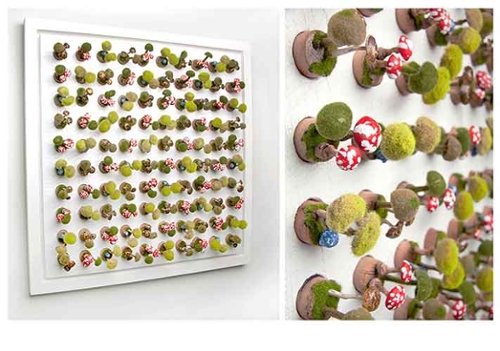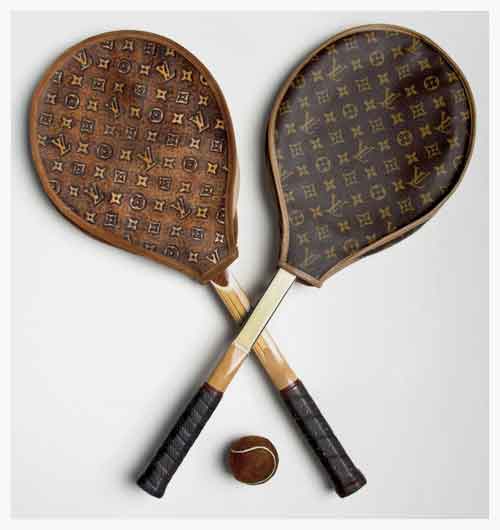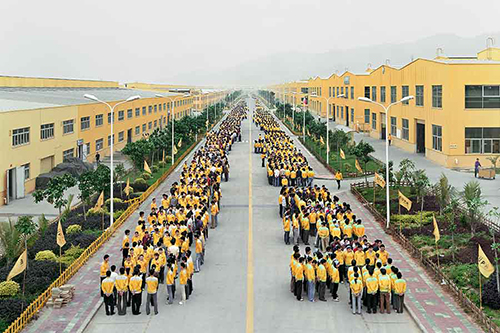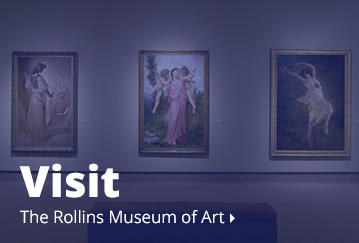Alfond Collection: Artists A-B
From Wade Aaron to Edward Burtynsky, explore the works of artists A-B in the Alfond Collection of Contemporary Art.
PLEASE NOTE: Not all works in the Rollins Museum collection are on view at any given time. View our Exhibitions page to see what's on view now. If you have questions about a specific work, please call 407-646-2526 prior to visiting.
Wade Aaron
(American, b. 1977)Assorted Thoughts and Aspirations, 2011
Dutch gold leaf and watercolor on paper
30 x 22 in.
The Alfond Collection of Contemporary Art, Gift of Barbara '68 and Theodore '68 Alfond, 2013.34.98. © Wade Aaron. Image courtesy of the artist.
The multidimensional quality of Wade Aaron’s Assorted Thoughts and Aspirations (2011) underscores the artist’s desire to make work that is “chiefly sculptural” across a variety of media. Here Aaron has drawn a series of narrow frames stacked to form a mismatched vertical tower, with the white forms distinguished from the background only by gentle shading and the lining of the volumes with Dutch gold leaf. This gesture of stacking recalls the signature works of Minimalist artist Donald Judd, but in its imperfection reveals Aaron’s own thoughts, aspirations, and visions, as an artist indebted to—but distinct from—his predecessors.
Aaron’s works are often models for knowledge: attempts to understand the reciprocity between the arrangement of the physical world and the way we organize ideas in our mind. Though there are high-tech ways to model the brain and give visible form to the countless processes that constitute thinking, Aaron’s visualizations are simpler and more open. They leave room for viewers to consider the way they arrange their own thoughts, which could involve stacked forms, but also drawers, grids, bubbles, or networks.
Aaron is reluctant to reveal too much of his intentions, preferring to engage viewers with open-ended suggestions. In a piece recently installed in the new contemporary wing of the Museum of Fine Arts, Boston, Aaron slowly drains his presence from the object in the most literal way. The work is comprised of fluorescent light bulbs that spell INTENT, and over time the sculpture will eventually burn out. It is up to us, then, to make something out of what remains. Similarly, could it be that the frames in this work are really destined for our own reflections and wishes? There’s something both reassuring and frightening about this: reassuring because a tangible set of thoughts and aspirations seems manageable, accessible, and generative; frightening because like a game of Jenga, those loosely stacked ideas might tumble at any moment.
--Kelly Presutti
Wade Aaron
(American, b. 1977)The Myth of Compromise, 2011
Aluminum leaf and watercolor on paper
22 1/2 x 30 in.
The Alfond Collection of Contemporary Art, Gift of Barbara '68 and Theodore '68 Alfond, 2013.34.99. © Wade Aaron. Image courtesy of the artist.
Ahmed Abdalla
(Egyptian American, b. 1963)Artist Statement, 2001
Ink and pigment on paper
31 x 21 in.
The Alfond Collection of Contemporary Art, Rollins Museum of Art. Gift of Barbara '68 and Theodore '68 Alfond, 2013.34.94. Image courtesy of the artist.
At the heart of both art and language lies the desire to communicate. Cultural histories and signifiers greatly influence context and understanding, and individual cultures often have different interpretations of the same letters, symbols, actions, images, and traditions. This incongruence points to the contradictory manner in which we communicate rather than the significance of what is actually being conveyed. This understanding is at the root of the interdisciplinary work of Egyptian-born artist and curator Ahmed Abdalla.
Painting is Abdalla’s primary focus as an artist. Egyptian art has had historical significance for thousands of years, and Abdalla’s gravitation to painting is due not only to its revered place in Egyptian culture, but also for its significance as a marker for the history of art as a whole. This history, however, is powerfully influenced by European and Western ideology, and Abdalla’s perspective on both art and culture evolved dramatically following his move to the Netherlands in the early 1990s and his subsequent move to the U.S. in 1994 to attend the School of the Museum of Fine Arts, Boston. In the two decades he has lived and worked in the States, Abdalla has become acutely aware of the disparities and similarities between distant cultures.
Artist Statement (2003) reflects the story of Abdalla’s experience in America. Quickly understood as a visual interpretation of the traditional first-person proclamation, the statement becomes the work—and vice versa. Cascading trails of symbols, color, and abstracted fragments of Arabic trickle down the sheet in paragraphic collections of ink. The symbols compose an invented visual language that is intuitive and informed by memory and association. Abdalla applies his cryptic writing––with origins in the changing shapes of the moon and the sun––with a calligraphic pen, the same tool used to inscribe verses of the Quran on traditional Arabic writing tablets. Focused on notions of communication and language, the artist gives further voice to his materials in this piece by using pigments and ink he made himself. Rooted in the ways in which we communicate rather than the substance of what is said, Abdalla’s practice uses notions of language to convey the very nature of expression.
--Evan J. Garza
Nina Chanel Abney
(American, b. 1982)Helen with the Drip, 2020
Acrylic and spray-paint on canvas
48 x 36 in.
The Alfond Collection of Contemporary Art, Gift of Barbara ’68 and Theodore ’68 Alfond. 2020.1.25 © Nina Chanel Abney. Courtesy of the artist and Jack Shainman Gallery, New York
Drawing on the rich traditions of figuration, murals, and history painting, Nina Chanel Abney combines representation and abstraction to create graphic works that critically investigate the dynamics of politics, race, sexuality, and public image. Abney’s unique visual style is influenced by diverse source material, including animation, graffiti, and hip hop. The artist improvises her compositions using stenciled shapes—dollar signs, X’s, evergreen trees, but also guns and skulls—asking viewers to consider the symbolism and meaning of each pattern. Helen with the Drip depicts a woodland setting of stylized tree leaves and conifers in which a Black figure caresses a fawn while an ominous human skull observes them from below. Part of a series titled The Great Escape, which challenges the traditional art historical association of pastoral landscapes with whiteness, this work presents an idyllic scene that reimagines the relationship between Black subjects and nature as a new space of refuge and leisure. Abney lives and works in New York.
Amy Adler
(American, b. 1966)Lockers, 2023
oil pastel on canvas
40 x 30 x 2 in.
The Alfond Collection of Contemporary Art, Rollins Museum of Art. Gift of Barbara '68 and Theodore '68 Alfond 2024.1.1. © Amy Adler. Courtesy of Night Gallery, Los Angeles
New York artist Amy Adler’s artwork explores themes of identity and power within contemporary society. With a background in film and photography, Adler creates bodies of work that she feels inhabit a shared cinematic universe, imbuing her oeuvre with a narrative essence. This work is related to works within her 2023 series, Audition, which examines “vulnerability, subject versus authorial agency, and queer desire” through large-scale, oil pastel paintings. Most of the works in Audition depict figures engaged in their own narrative. Lockers breaks Adler’s focus on the figure, instead emphasizing setting through the intimate space of the locker room. This work acts as a shared backdrop for the actors of her universe to experience potentially vulnerable, cruel, or transformative moments. Without depicting the physical figures, Adler creates a space where all her characters have the potential to interact and encourages reflection on how certain spaces allow for shared experiences.
Sonia Almeida
(Portuguese, b. 1978)Silver Screen, 2013
Oil and green LEDs on marine plywood
64 x 82 in.
The Alfond Collection of Contemporary Art, Gift of Barbara '68 and Theodore '68 Alfond, 2013.34.137. Image courtesy of the artist. Photo credit: Joerg Lohse.
There is a science to bloodstains. Their shapes and patterns evince how the properties of our blood—viscous, red, emphatic—meet the physics of the world, its undeniable gravity and surface tension. The purpose of such a forensic formalism is evidential: the stain narrates, in its shocking muteness, an event, a trace. Is the brushstroke like a bloodstain?
For all the rigor of their many references, ranging from color theory to information science, the paintings of Sonia Almeida are encounters with the spatial, pictorial, and historical limits of a space. The canvases are more or less filled, motifs abutting within the picture plane; some of these depicted objects are obviously referential, literal or mimetic, while others are less so. Nearly all of the paintings hold subject and object matter in this dialectical play, attempting to resolve, within the defined illusionistic space of a painting, both what is represented within it, and what the painting itself announces as its subject. As such, the paintings offer an encounter with the physical and affective space of abstraction. Each painting seems to work over, and revisit, the internal space of illusion, both literally and ideationally; likewise, each mark, each gesture, confronts the space between abstraction and representation, precisely where a paint drop becomes a bloodstain.
Almeida’s marks, gestures, and shapes don’t simply function as evidential, however—that is, as so many expressive markers or registers of thinking, acting, or moving. Rather, her motifs suggest a tension between form and materiality, like that between the technologies for the spectral analysis of light and its qualitative evaluation by human sight. Is it experience that gives blood-red its marked difference from any other color? So the grid, which structures nearly all of Almeida’s work in varying degrees, is sometimes literally present, while at other times it recedes, defining but diffused like a mist. In some paintings, the soft geometry of the loose mass of lines falsely hints at a freedom within the space of the picture. Yet for all their regulation—CMYK, parametric geometries, etc.—and the physical limits knowingly acknowledged in Almeida’s paintings, color and space are also part of our intuition, our memory, our conjecturing about the world.
Abstraction, in its course through the history of twentieth-century art, is not only about space, shape, or form, but about a seeing of the world, or better, of the world having-been-seen. So forensics might be the science of bloodstains, but it is in the blood that the repulsion and fascination lie, both the pattern and the crime.
--João Ribas
Darren Almond
(British, b. 1971)To Leave a Light Impression, 2013
Cast Bronze and paint
7 5/16 x 90 15/16 x 1/2 in.
The Alfond Collection of Contemporary Art, Gift of Barbara '68 and Theodore '68 Alfond, 2014.1.38. © Darren Almond. Image courtesy of White Cube, London. Photo Credit: Jack Hems.
“Between here and the surface of the moon.” Although the phrase lacks a verb, it somehow conveys a sense of dynamism, of movement from one point to another. To Leave a Light Impression (2013) belongs to Darren Almond’s Trainplate series, in which words are cast in bronze to recall the plates that bear the names and numbers of British trains. Raised in the coal-mining town of Wigan in the north of England, Almond developed an early interest in trains and spent countless hours of his childhood trainspotting.[1] Trains figure prominently in Almond’s artistic practice, which engages themes of travel and discovery and encompasses photography, film, and sculpture. Almond has journeyed to all seven of the world’s continents for his work, explaining, “I think [travel is] about being in an environment that you’re unaccustomed to. It alerts your perception, makes you a little more vulnerable to your conscious instincts—there’s something instinctive. I like that vulnerability of not really knowing where I am.”[2] The state of unfamiliarity Almond experiences in these faraway places heightens his awareness of his surroundings, allowing him to discover what is truly noteworthy about his subject matter.
The fragmentary nature of the language in To Leave a Light Impression makes any “meaning” in the work unclear and opens it to multiple interpretations.[3] The words cast into the surface of the sculpture may refer to the desire to travel, evident in much of Almond’s work. The words “between here and the surface of the moon” might also be taken in combination with the title of the piece to form a more complete thought. Read as a unit, they may refer to environmental impact: the words might implore us to consider our influence on that which lies between here and the surface of the moon, including our planet. Environmental concerns are a recurrent theme in Almond’s photographs, which document the damage humans have inflicted on even remote parts of the world.
Finally, the two phrases together might refer to the process of photography itself.
To Leave a Light Impression shares its title with a 2014 exhibition of Almond’s work at White Cube gallery in London. Among the works featured were images from Almond’s Fullmoon series, for which he photographed locations across the globe under a full moon using a prolonged exposure of up to ninety minutes.[4] In these photographs, Almond creates the very impression of light itself.
--Davida Fernández-Barkan
[1] Kathleen Madden, “Selected Works,” in Darren Almond: Index, exh. cat. (Parasol united/Koenig Books, London, 2008), 138.
[2] White Cube, “Darren Almond: To Leave a Light Impression,” accessed October 30, 2014, http://whitecube.com/exhibitions/darren_almond_to_leave_a_light_impression_bermondsey_2014/; Harriet Thorpe, “Darren Almond: To Leave a Light Impression,” Studio International, January 26, 2014, http://www.studiointernational.com/index.php/darren-almond-to-leave-a-light-impression-interview-white-cube.
[3] Sean O’Hagan, “Night Visions: Darren Almond’s Full-Moon Landscapes,” The Guardian, January 14, 2014, http://www.theguardian.com/artanddesign/2014/jan/21/darren-almond-moonlight-landscape-photography.
[4] “Darren Almond Leaves a Light Impression,” The Telegraph, February 7, 2014, http://www.telegraph.co.uk/luxury/art/23683/darren-almond-leaves-a-light-impression.html.
Francis Alÿs
(Belgian, b. 1959)Untitled, 1996
Oil on canvas mounted on panel
11.25 x 8.5 in.
The Alfond Collection of Contemporary Art, Gift of Barbara '68 and Theodore '68 Alfond, 2014.1.38. © Francis Alÿs. Image courtesy of David Zwirner, New York/London
Leo Amino
(American, 1911-1989)Triumphant Warriors, 1951
Mahogany
47 x 16 x 12 in.
The Alfond Collection of Art, Gift of Barbara '68 and Theodore '68 Alfond, 2017.15.13, Image courtesy of Julie Amino and Family.
Leo Amino came to the United States in 1929 to attend college, first at San Mateo Junior College and then New York University. In 1937 he began studying sculpture under Chaim Gross at the American Artists School in New York, where he was particularly interested in direct carving into wood and other materials. He was deeply immersed in the discourses of Surrealism, and he sought to capture and represent the interrelated forms of nature and the human unconscious. After the Japanese attack on Pearl Harbor he joined a group of fellow Japanese-American artists in denouncing Imperial Japan and declaring their loyalty to the United States, serving as a translator in the United States Navy during World War II.
After the war Amino became associated with the group of Abstract Expressionist sculptors in New York, fusing his interest in abstract Surrealism with an interest in new materials, in particular the plastic resins that had come into wide use as substitutes for scarce metals during the war. He also became a teacher, teaching first at the summer session at the famed Black Mountain College before becoming an instructor at Cooper Union in New York, where he taught for over twenty years.
This sculpture is a prime example of his mature work, blending his skill at carving with his interest in natural forms. The long, thin, attenuated nature of the work is somewhat at odds with the title, which implies a solid and muscular physicality. Particularly striking is his use of negative space, which provides the sculpture with a light and airy quality.
Shimon Attie
(American, b. 1957)Finders Keepers, Two On-location Light Boxes Looking onto Temple Mount/Noble Sanctuary, Old City, Annexed by Israel in 1967, 2014
Digital C-print
48 x 72 in.
The Alfond Collection of Contemporary Art, Gift of Barbara '68 and Theodore '68 Alfond, 2015.1.1. © Shimon Attie. Image courtesy of the artist and Jack Shainman Gallery, New York.
Since the 1990s, Shimon Attie has been using video and photography to peel back the layers of history and conflict in physical territory. In his site-specific installations, Attie utilizes the temporal clash between projected, moving images and actual, static architecture to transport us into oft-forgotten pasts. His projects from Berlin to New York have largely dealt with issues of war, immigration, and the resulting complications in identity, specifically as they relate to the Holocaust and World War II.
In his most recent work, Attie addresses the ongoing and increasingly worrisome conflict in the Middle East around Israeli and Palestinian territory. Attie was raised in an Arab Jewish family in the Middle East and United States, and his own biography embodies a seemingly dichotomous binary of Arab and Jewish cultures. But it is with this same fluidity of nationality and identity that Attie approaches this struggle in a new group of photographs and video.
FINDERS, KEEPERS, Two on-location light boxes looking onto Temple Mount / Noble Sanctuary, Old City, annexed by Israel in 1967, East Jerusalem (2014), much like Attie’s earlier installations, mines the inherent contrast and tension between image, text, and site. While the hilltop view reads as a generic postcard for Jerusalem, featuring the iconic gold dome of the seventh-through-sixteenth–century Dome of the Rock mosque on the horizon line, Attie’s full title and light box insertions make a pointed political statement. Using both Israeli and Palestinian names for the ancient hilltop in the title, Temple Mount and Noble Sanctuary, Attie points to the trans-religious significance of the site and the deeply bifurcated view of Jerusalem at the very core of the Israeli/Palestinian conflict. While the location remains sacred to both Jews and Muslims, as the site of the Jewish Temple and the Prophet’s ascent, Attie’s light box text, “Finders, Keepers,” stresses that this has been a contested area for centuries as an icon of religious belief that has, in turn, translated into political power. Using a phrase more apt for the playground than the negotiating table, Attie evokes the stubbornly emotional character of this ongoing clash. As the title further notes, Attie photographed the city from the viewpoint of Palestinian East Jerusalem, itself a highly contested territory, a reminder, perhaps, of how entrenched perspectives are difficult to unwind.
Today, the Old City of Jerusalem, like the entire city and surrounding country, is divided between Palestinian and Israeli sovereignty in a clearly uneasy balance, based on both historic and religious claims for rightful rule. Attie’s jarring gesture of placing bold text within this politically fraught landscape creates an image that operates on multiple levels at once, much like the very nature of this age-old struggle.
--Dina Deitsch
June August
(American, b. 1957)3 Muses Blue, 2014
Silk screen on BFK Rives 300gm paper
34 1/2 x 31 1/2 in.
The Alfond Collection of Contemporary Art, Gift of Barbara '68 and Theodore '68 Alfond, 2017.6.42. Image courtesy of the artist.
Inspired by her time in Japan as a result of a research fellowship at Tokyo University of Arts, June August developed one of the primary themes for her work, “art about art,” by examining the inter-relationship between the high art of Japan’s Edo period and the popular art of manga and anime in its modern culture. In her Pop Art coloring and style, August creates works saturated with references to different artists, including Japanese artist Takashi Murakami and American artist Andy Warhol, and artistic periods, including the Renaissance and Classical Antiquity, as is seen in these works. In Greek mythology, the muses are inspirational goddesses of literature, science, and the arts, and the number three is a universal symbol of unity and divinity. Rendering this classical subject in a modern style, August playfully draws connections between these distant periods in art history.
June August
(American, b. 1957)3 Muses Yellow, 2014
Silk screen on BFK Rives 300gm paper
34 1/2 x 31 1/2 in.
The Alfond Collection of Contemporary Art, Gift of Barbara '68 and Theodore '68 Alfond, 2017.6.43. Image courtesy of the artist.
June August
(American, b. 1957)3 Muses Pink, 2014
Silk screen on BFK Rives 300gm paper
34 1/2 x 31 1/2 in.
The Alfond Collection of Contemporary Art, Gift of Barbara '68 and Theodore '68 Alfond, 2017.6.44. Image courtesy of the artist.
Firelei Báez
(Dominican, b. 1981)An Open Horizon (or the stillness of a wound), 2019
Acrylic and oil on archival printed canvas
The Alfond Collection of Contemporary Art, Gift of Barbara '68 and Theodore '68 Alfond, 2019.2.6. © Firelei Báez. Image courtesy of the artist and James Cohan, New York. Photo: Jackie Furtado
Born in Santiago de los Caballeros, Dominican Republic, Firelei Báez grew up in Miami and currently lives and works in New York. Her research based practice addresses, among other things, the history and construction of identity in diasporic societies. Báez examines these topics in a variety of media, mixing traditional painting techniques, with collage, architectural drawings and decommissioned documents she obtains from libraries and archives in the U.S. and abroad. In this work, the artist conflates history and contemporary issues by placing two figures based on a YouTube video of a wildin’ (a phenomenon in which young women of color engage in staged fights) over the architectural plan of the Bayou St. John Bridge in New Orleans. Here, the allusion to a site tied to the flooding and aftermath of Hurricane Katrina functions as the backdrop for the physical struggle of the figures whose silhouetted bodies are adorned by a Rococo-style pattern. The combination of these visual elements invites a reflection on the effects of colonialism and take on new meaning as we consider their symbolism today.
Richard Baker
(American, b. 1959)The Picture of Dorian Gray, 2013
Gouache on paper
14 1/4 x 11 3/4 in.
The Alfond Collection of Contemporary Art, Rollins Museum of Art. Gift of Barbara ’68 and Theodore ’68 Alfond, 2013.34.123. Image courtesy of the artist and Clark Gallery, Lincoln, Massachusetts
Richard Baker
(American, b. 1959)Dreaming the Rational City, 2013
Gouache on paper
14 1/4 x 11 3/4 in.
The Alfond Collection of Contemporary Art, Rollins Museum of Art. Gift of Barbara ’68 and Theodore ’68 Alfond, 2013.34.124. Image courtesy of the artist and Clark Gallery, Lincoln, Massachusetts
Richard Baker
(American, b. 1959)A Challenge for the Actor, 2013
Gouache on paper
14 1/4 x 11 1/4 in.
The Alfond Collection of Contemporary Art, Rollins Museum of Art. Gift of Barbara '68 and Theodore '68 Alfond, 2013.34.125. Image courtesy of the artist and Clark Gallery, Lincoln, MA.
Despite the constant bemoaning regarding the book’s endangered status in the electronic age, it remains a precious object to many of us. Books serve as constant companions, old friends, and invitations to new worlds; they tie us to our past selves and open us to future possibilities. They become part of us as we become part of them through marks scribbled in margins, dog-eared pages, cracked spines, and well-worn covers.
Still-life painter Richard Baker has recently introduced books as his subject, valorizing their status as both physical and content-laden objects. Painting in gouache on paper, he lends a frank, deadpan quality to images showing the book cover and spine nearly straight on in a brightly lit, shallow white space. The books he depicts bear the traces of time and the vestigial presence of the reader in smudges and torn pages. The readers, in this case, are faculty members at Rollins College. For the Alfond Collection of Contemporary Art, Baker was commissioned to paint books that faculty considered essential to their intellectual or emotional life. Looking at the images, we gain a surprisingly vivid sense of the person who chose each book. Baker’s paintings are as much about these individuals, as about the books themselves.
Still lifes are inherently material and tactile. They are capable of drawing our attention to the smallest detail––a fly perched on a flower, a reflection glinting along the edge of a knife. The famed 17th-century Dutch trompe l’oeil paintings delight viewers with their verisimilitude, fooling the eye into recognizing the clarity of glass, the robust brightness of a lemon peel, the texture of a crumpled tablecloth. Still lifes augment our experience of things, which Baker’s work is intended to reclaim: the perception of these material objects that, though they may go unnoticed, contribute in innumerable ways to the people we become.
--Kelly Presutti
Richard Baker
(American, b. 1959)The Complete C.S. Lewis, 2013
Gouache on paper
14 1/4 x 11 3/4 in.
The Alfond Collection of Contemporary Art, Rollins Museum of Art. Gift of Barbara ’68 and Theodore ’68 Alfond, 2013.34.126. Image courtesy of the artist and Clark Gallery, Lincoln, Massachusetts
Richard Baker
(American, b. 1959)All in the Timing, 2013
Gouache on paper
14 1/4 x 11 3/4 in.
The Alfond Collection of Contemporary Art, Rollins Museum of Art. Gift of Barbara ’68 and Theodore ’68 Alfond, 2013.34.127. Image courtesy of the artist and Clark Gallery, Lincoln, Massachusetts
Richard Baker
(American, b. 1959)Bi An (The Other Shore), 2013
Gouache on paper
14 1/4 in. x 11 1/4 in.
The Alfond Collection of Contemporary Art, Rollins Museum of Art. Gift of Barbara '68 and Theodore '68 Alfond, 2013.34.16. Image courtesy of the artist and Clark Gallery, Lincoln, MA.
Richard Baker
(American, b. 1959)Christy, 2013
Gouache on paper
14 1/4 in. x 11 1/4 in.
The Alfond Collection of Contemporary Art, Rollins Museum of Art. Gift of Barbara '68 and Theodore '68 Alfond, 2013.34.14. Image courtesy of the artist and Clark Gallery, Lincoln, MA.
Richard Baker
(American, b. 1959)Circles on the Water, 2013
Gouache on paper
14 1/4 in. x 11 1/4 in.
The Alfond Collection of Contemporary Art, Rollins Museum of Art. Gift of Barbara '68 and Theodore '68 Alfond, 2013.34.19. Image courtesy of the artist and Clark Gallery, Lincoln, MA.
Richard Baker
(American, b. 1959)East of Eden, 2013
Gouache on paper
14 1/4 in. x 11 1/4 in.
The Alfond Collection of Contemporary Art, Rollins Museum of Art. Gift of Barbara '68 and Theodore '68 Alfond, 2013.34.129. Image courtesy of the artist and Clark Gallery, Lincoln, MA.
Richard Baker
(American, b. 1959)Hawaii, 2013
Gouache on paper
14 1/4 in. x 11 1/4 in.
The Alfond Collection of Contemporary Art, Rollins Museum of Art. Gift of Barbara '68 and Theodore '68 Alfond. Image courtesy of the artist and Clark Gallery, Lincoln, Massachusetts.
Richard Baker
(American, b. 1959)Foundation, 2013
Gouache on paper
14 1/4 x 11 3/4 in.
The Alfond Collection of Contemporary Art, Rollins Museum of Art. Gift of Barbara ’68 and Theodore ’68 Alfond, 2013.34.133. Image courtesy of the artist and Clark Gallery, Lincoln, Massachusetts
Richard Baker
(American, b. 1959)Major American Poets, 2013
Gouache on paper
14 1/4 in. x 11 1/4 in.
The Alfond Collection of Contemporary Art, Rollins Museum of Art. Gift of Barbara '68 and Theodore '68 Alfond, 2013.34.20. Image courtesy of the artist and Clark Gallery, Lincoln, MA.
Richard Baker
(American, b. 1959)The Star of Redemption, 2013
Gouache on paper
14 1/4 x 11 3/4 in.
The Alfond Collection of Contemporary Art, Rollins Museum of Art. Gift of Barbara ’68 and Theodore ’68 Alfond, 2013.34.20. Image courtesy of the artist and Clark Gallery, Lincoln, Massachusetts
Richard Baker
(American, b. 1959)Men, Women, and Pianos, 2013
Gouache on paper
14 1/4 in. x 11 1/4 in.
The Alfond Collection of Contemporary Art, Rollins Museum of Art. Gift of Barbara '68 and Theodore '68 Alfond, 2013.34.17. Image courtesy of the artist and Clark Gallery, Lincoln, MA.
Richard Baker
(American, b. 1959)New Hampshire, 2013
Gouache on paper
14 1/4 in. x 11 1/4 in.
The Alfond Collection of Contemporary Art, Rollins Museum of Art. Gift of Barbara '68 and Theodore '68 Alfond, 2013.34.18. Image courtesy of the artist and Clark Gallery, Lincoln, MA.
Richard Baker
(American, b. 1959)Plato, 2015
Gouache on paper
14 1/4 in. x 11 1/4 in.
The Alfond Collection of Contemporary Art, Rollins Museum of Art. Gift of Barbara '68 and Theodore '68 Alfond, 2015.1.44. Image courtesy of the artist and Clark Gallery Lincoln, Massachusetts.
Richard Baker
(American, b. 1962)The Portable Nietzsche, 2013
Gouache on paper
14 1/4 in. x 11 1/4 in.
The Alfond Collection of Contemporary Art, Rollins Museum of Art, Gift of Barbara ’68 and Theodore ’68 Alfond, 2013.34.130. Image courtesy of the artist and Clark Gallery, Lincoln, Massachusetts
Richard Baker
(American, b. 1959)Gulliver's Travels, 2013
Gouache on paper
14 1/4 x 11 3/4 in.
The Alfond Collection of Contemporary Art, Rollins Museum of Art. Gift of Barbara ’68 and Theodore ’68 Alfond, 2013.34.131. Image courtesy of the artist and Clark Gallery, Lincoln, Massachusetts
Richard Baker
(American, b. 1962)The Portrait of a Lady, 2013
Gouache on paper
14 1/4 in. x 11 1/4 in.
The Alfond Collection of Contemporary Art, Rollins Museum of Art, Gift of Barbara ’68 and Theodore ’68 Alfond, 2013.34.128. Image courtesy of the artist and Clark Gallery, Lincoln, Massachusetts
Richard Baker
(American, b. 1959)Tres Tristes Tigres, 2013
Gouache on paper
14 1/4 in. x 11 1/4 in.
The Alfond Collection of Contemporary Art, Rollins Museum of Art. Gift of Barbara '68 and Theodore '68 Alfond, 2013.34.15. Image courtesy of the artist and Clark Gallery, Lincoln, MA.
Olivo Barbieri
(Italian, b. 1954)Capri #7, from the series Capri, 2013
Archival Pigment Print
65 x 85 in.
The Alfond Collection of Contemporary Art, Gift of Barbara '68 and Theodore '68 Alfond, 2013.34.138. © Olivo Barbieri. Image courtesy the artist and Yancey Richardson Gallery, New York.
Picture Capri: azure waters, luxury yachts, suntanned bathers. Now look at Italian photographer Olivo Barbieri’s Capri #7, an image that is the antithesis of our vision: bright orange, looming, otherworldly. Conditioned as we are by the tropes and conventions surrounding famous landscapes—not only the island of Capri but also the Alps, or the great lawn of Central Park—we can find Barbieri’s images shocking. As a site-specific artist, he joins a tradition of artists engaging with place. Most famously described by art historian Miwon Kwon, site-specific art allows itself to be determined by its environmental context. Yet Barbieri’s practice inverts our understanding of site specificity: rather than using the characteristics of a place to legitimate the artwork, he uses the artwork to undermine the legitimacy of the place. Though he insists on their indexical quality—“They are all real!” he claimed in one interview—there is a distinct sense of unreality in Barbieri’s images.
For ten years, Barbieri focused on scenes of cities seen from above. The bird’s-eye view, a novelty in the early years of photography, is becoming commonplace in today’s world of Google Maps and drones. But instead of offering a definitive account of the location, Barbieri’s images are often deliberately disorienting. Shooting from a helicopter, he captured wide expanses and relied on photographic tricks like tilt-shift lenses to produce images that looked more like toy towns than looming metropolises. These experiments in the visual language of photography use the medium against itself, deliberately unmooring image from actuality.
Capri #7 is part of the Parks series, which includes shots of the Alps and the Dolomites, all rendered fantastical through Barbieri’s particular gaze and post-photographic processing. His photographs open up well-known sites to new interpretations, and his work participates in art’s ongoing imperative to make the familiar strange again, pushing us to rethink our encounters with everyday landscapes.
--Kelly Presutti
Gideon Barnett
(American, b. 1982)763 Collins Avenue, 2:41:42 PM, 15 September, 2012, Miami Beach, Florida, 2012
Pigment ink print on cotton rag paper cold-mounted to dibond in artist's frame
14 x 14 in.
The Alfond Collection of Contemporary Art, Gift of Barbara '68 and Theodore '68 Alfond, 2013.34.49. Image courtesy of the artist.
One of the most popular early applications of photography was the carte de visite, a small calling card featuring a photographic portrait that was distributed and traded among friends and guests in late 19th-century Paris. Photography’s mechanical ability to fix a human subject and preserve it for posterity was hugely desirable during this period, and portraiture has continued to hold a central place within the medium. From Walker Evans’s 1930s images of rural farmhands for the Farm Security Administration to Catherine Opie’s 1980s–’90s investigations of the LGBT community, photography’s exploration of issues of identity remains vital.
Gideon Barnett draws directly on the legacy of Walker Evans in his series 736 Collins Avenue. As if setting a “trap” for his subjects, Barnett framed a section of a Miami sidewalk adjacent to a luminous blue building and “captured” anonymous denizens. Each final print is a small, discrete image of a circumscribed figure, titled by the exact moment at which the shutter opened. Some glance toward the photographer, perhaps aware of his presence, but most are immersed in their own reality. The lush tropical-blue background, the central positioning of the figure, and the high degree of resolution evoke a formal studio portrait, but the shadows of fellow passersby remind us that we are looking at just one figure among many, a person in motion whose presence is only momentary. Suspended, then, between insightful portrait and casual snapshot, Barnett’s photographs reveal something of his subjects’ identity not as they choose to present themselves, but as they are seen.
In Identity Festival Attendees at Biscayne Boulevard and NE 2nd Street, 4:45:32 PM to 4:45:51 PM, 4 August 2012, Barnett brings the intensity of detail and personal engagement in the 736 Collins Avenue portraits to a group scene. The print is a composite of roughly 20 photographs, each made with a 19-second exposure, digitally recombined to give a level of clarity impossible to achieve within a single image. Barnett frequently draws on the history of art: here, Ilya Repin’s Religious Procession in Kursk Province (1880–1883) inspired the processional feel and multiple vignettes of participants in the Identity Festival, an electronic music festival in Miami. The subjects emerge as both distinct personalities and members of a collective practice, a fitting way to understand identity formation today, supported by photography’s capacity for both indexicality and invention.
--Kelly Presutti
Gideon Barnett
(American, b. 1982)763 Collins Avenue, 2:43:42 PM, 15 September 2012, Miami Beach, FL, 2012
Pigment ink print on cotton rag paper cold mounted to dibond in artist's frame
14 x 14 in.
The Alfond Collection of Contemporary Art, Gift of Barbara '68 and Theodore '68 Alfond, 2013.34.52. Image courtesy of the artist.
Gideon Barnett
(American, b. 1982)763 Collins Avenue, 5:39:36 PM, 19th August, 2012, Miami Beach, Florida, 2012
Pigment ink print on cotton rag paper cold-mounted to dibond in artist's frame, 1 of 3 (1 AP)
14 x 14 in.
The Alfond Collection of Contemporary Art, Gift of Barbara '68 and Theodore '68 Alfond, 2013.34.50. Image courtesy of the artist.
Gideon Barnett
(American, b. 1982)763 Collins Avenue, 5:56:11 PM, 19th August, 2012, Miami Beach, Florida, 2012
Pigment ink print on cotton rag paper cold-mounted to dibond in artist's frame, 1 of 3 (1 AP)
14 x 14 in.
The Alfond Collection of Contemporary Art, Gift of Barbara '68 and Theodore '68 Alfond, 2013.34.53. Image courtesy of the artist.
Gideon Barnett
(American, b. 1982)763 Collins Avenue, 6:41:47 PM, 19th August, 2012, Miami Beach, Florida, 2012
Pigment ink print on cotton rag paper cold-mounted to dibond in artist's frame, 1 of 3 (1 AP)
14 x 14 in.
The Alfond Collection of Contemporary Art, Gift of Barbara '68 and Theodore '68 Alfond, 2013.34.51. Image courtesy of the artist.
Gideon Barnett
(American, b. 1982)763 Collins Avenue, 6:49:53 PM, 19 August 2012, Miami Beach, FL, 2012
Pigment ink print on cotton rag paper cold mounted to dibond in artist’s frame
14 x 14 in.
The Alfond Collection of Contemporary Art, Gift of Barbara '68 and Theodore '68 Alfond, 2013.34.48. Image courtesy of the artist.
Gideon Barnett
(American, b. 1982)763 Collins Avenue, 7:04:59 PM, 5 August 2012, Miami Beach, FL, 2012
Pigment ink print on cotton rag paper cold mounted to dibond in artist’s frame
14 x 14 in.
The Alfond Collection of Contemporary Art, Gift of Barbara '68 and Theodore '68 Alfond, 2013.34.47. Image courtesy of the artist.
Sadie Barnette
(American, b. 1984)Untitled (Family Style), 2017
Graphite and aerosol paint on paper
19 1/2 x 16 1/2 in.
The Alfond Collection of Contemporary Art, Gift of Barbara '68 and Theodore '68 Alfond, 2017.6.48. Image courtesy of the artist and Fort Gansevoort.
Sadie Barnette incorporates diverse influences from hip hop and graffiti to her childhood across her multifaceted body of work. This work is from a series in which the artist mines personal narratives and her family’s history. In 2011 the artist and her father, Rodney Barnette, used the Freedom of Information Act to obtain the 500-page FBI file that had been compiled on Rodney while he was a member of the Black Panthers in the 1960s. Here she combines the phrase “family style” and a single pink aerosol mark, which can be interpreted in multiple ways. In a recent interview she shared: “Pink is often thought of as this frivolous, unserious color. But it’s actually quite powerful and takes up a lot of space. Pink turns up the volume on this youthful, high-femme language and aesthetic that people use to tell you about themselves and shine in the world.”
Sadie Barnette
(American, b. 1984)Untitled (FBI, Racial Matters), 2016
Aerosol paint on laser print
30 x 22 in.
The Alfond Collection of Contemporary Art, Gift of Barbara '68 and Theodore '68 Alfond, 2016.3.22. Image courtesy of the artist and Fort Gansevoort.
In 2016 Sadie Barnette gained access to around 500 pages from the FBI on her father, a postal worker and a former Black Panther Party member. The files confirmed the family's belief that their father had been surveilled. FBI agents working for the covert program COINTELPRO collected decades worth of information on her father’s life and labeled him as an extremist. Barnette cropped and zoomed into the areas she believed mattered most in these documents. Splattered with pink and black spray paint, Barnette has not only placed her own mark and redactions on the text, but also evokes the blood splatter that results from scenes of violence and conflict. Barnette’s markings also speak to the connection of graffiti with African American culture. This piece, which is part of her My Father’s FBI File, Project III (2017) series plays with the idea of reclaiming one's past and controlling the narrative.
Sadie Barnette
(American, b. 1984)Untitled (Pointing in pink), 2017
Collage
16 1/4 x 13 3/4 in.
The Alfond Collection of Contemporary Art, Gift of Barbara '68 and Theodore '68 Alfond, 2017.6.49. Image courtesy of the artist and Fort Gansevoort.
Jennifer Bartlett
(American, b.1941)Alphabet Six, 1993
Enamel over silkscreen grid on baked enamel, steel plates
90 x 77 in.
The Alfond Collection of Contemporary Art, Gift of Barbara '68 and Theodore '68 Alfond, 2018.1.33. © Jennifer Bartlett. Image courtesy Marianne Boesky Gallery, New York and Aspen, Paula Cooper Gallery, New York, and The Jennifer Bartlett 2013 Trust.
This piece was created using thirty-seven steel plates coated with enamel. Each plate contains a light-gray grid mimicking graph paper; it calls upon practices of earlier modern artists and offers the impression of versatility and the potential to erase and rework each square. The use of steel plates was also inspired by the subway signs of New York City. In this work, as is characteristic of her style, Bartlett uses basic symbols like rectangles, crescents, and complex fractal-like forms, in all the plates except one. The thirty-seventh plate deviates from an interest in the abstract by providing a sketched rabbit. Though visually different, the artist does not find the two styles to be at odds. In her words, “The question I was never able to understand was the fight between abstract and figurative art. It made no sense to me.”
Jennifer Bartlett
(American, b. 1941)Rose, 2010-11
Oil on canvas
72 x 144 in.
The Alfond Collection of Contemporary Art, Gift of Barbara '68 and Theodore '68 Alfond, 2018.1.34. Image courtesy Marianne Boesky Gallery, New York and Aspen, Paula Cooper Gallery, New York, and The Jennifer Bartlett 2013 Trust.
Bartlett’s two-paneled painting of roses, a more recent variation of the style that has defined the artist’s lengthy career, depicts roses grown by the artist in her Brooklyn studio garden. Systems of squares and grids dominate many of her works and here, the two 72-inch square panels recall the format of a grid. With close inspection of the paintings, another more intricate gridlike system emerges through a pattern of cross-hatched lines created by a graining brush. The artist worked from a photograph and made several changes to the painting, and the views of the roses are slightly distorted. Though the artist noted that “I like seeing things kind of ‘off’ and from different points of view. The two panels create discord,” this painting nevertheless, offers a sense of harmony throughout the work.
Math Bass
(American, b. 1981)Newz!, 2015
Gouache on canvas
40 x 38 in.
The Alfond Collection of Contemporary Art, Gift of Barbara '68 and Theodore '68 Alfond, 2018.1.1. Image courtesy of the artist and Tanya Leighton, Berlin.
Newz!, a series Math Bass started in 2012, recalls production and consumption and perhaps suggests viewers can “read” her paintings. Ripe with familiar multifaceted images, she intentionally emphasizes ambiguity, invites different interpretations, and inspires new discovery in language within each composition. Bass critiques the established cultural tendency to decode, and encourages viewers to focus, instead, on the experiential. Painted on raw canvas, her symbols are reminiscent of abstracted sign painting designs. The play in shapes, colors, and lines generate a tension between action and containment in the composition. Certain elements seem to come alive. The repeated black and white shapes on the right side of the painting appear cut off at the top and bottom to evoke a vertical conveyor belt-like motion. The artist’s exploration in spatial relationships emerges across her work in painting, performance, sculpture, and video art.
Julie Beaufils
(French, b. 1987)Pool, 2022
Oil on Canvas
51 1/8 x 51 1/8 in.
The Alfond Collection of Contemporary Art, Rollins Museum of Art. Gift of Barbara '68 and Theodore '68 Alfond, 2023.1.9 © Julie Beaufils
McArthur Binion
(American, b. 1986)DNA: Black Painting: Ph Bk/B Cert: 1, 2015
Oil paint stick and paper on board
48 x 72 x 2 1/2 in.
The Alfond Collection of Contemporary Art, Rollins Museum of Art. Gift of Barbara '68 and Theodore '68 Alfond, 2015.1.42 © McArthur Binion. Image courtesy Galerie Lelong, New York.
This painting is part of McArthur Binion’s series titled DNA:Work, a project examining both his early roots in the rural south and experience as an emerging artist in New York during the 1970s. The minimalist grid in this work initially captures the eye, and upon a closer look, collaged reproductions of Binion’s personal documents from throughout his life—such as his birth certificate from Mississippi and a hand-written contact list from his early years in New York—can be clearly recognized. He worked by copying personal documents, cutting them apart, and collaging them onto the board; he has stated that “labor has always been super important to the work.” The large scale of this piece contrasts with the miniscule details found in it, reminding the viewer of Binion’s meticulous, physical process of creation. The abstracted composition becomes deeply personal and implies his autobiography rather than narrating it overtly.
Hock E Aye Vi Edgar Heap of Birds
(American, b. 1954)Trail of Tears 1, 2005
Four aluminum panels
18 x 109 ½ in. (overall)
The Alfond Collection of Contemporary Art, Gift of Barbara ’68 and Theodore ’68 Alfond. 2020.1.2 © Hock E Aye Vi Edgar Heap of Birds. Image courtesy of the artist and Fort Gansevoort.
Cheyenne and Arapaho Nation artist Hock E Aye Vi Edgar Heap of Birds interrogates America’s colonial past to criticize the historical treatment of Native populations and elevate the experiences of indigenous people. Born in Wichita, Kansas, the artist studied art at the Royal College of Art in London and later earned his MFA at the Tyler School of Art at Temple University. In 1981, the artist relocated to Oklahoma where he lived for a period on a Cheyenne reservation before settling in Oklahoma City where he taught at the University of Oklahoma from 1988 to 2018. Heap of Birds’ artistic practice is highly multi-media and multi-disciplinary in nature, ranging from public art projects to monumental paintings, outdoor sculpture, large-scale prints, and multifaceted works.
Across all of his artistic projects, Heap of Birds raises his voice to assert his artistic aim: “The real mission of my art is to reset history, to be truthful about what happened to Native people.” Often incorporating text in his practice, the artist creates striking works that underscore the power of language in shaping identity, society, and land. In employing—or even weaponizing—words in his artworks, Heap of Birds is able to directly confront his American viewers with their colonial pasts. One such text-based work is the artist’s Trail of Tears 1 which adopts the form of pedestrian signs to evoke the infamous Trail of Tears. Following the Indian Removal Act of 1830, the United States under President Andrew Jackson began the forced relocation of Southeastern tribes, including the Cherokee, Chikasaw, and Muscogee Creek Nation. Over the course of this westward migration, an estimated 15,000 of a total of 100,000 Native people died of cold, hunger, and disease. In four simple, direct phrases, Heap of Birds recalls this despicable event in American history and provokes his viewers to grapple with the violent legacy of American colonialism.
Mel Bochner
(American, b. 1940)Blah Blah Blah, 2013
Monoprint with collage, engraving and embossment on hand-dyed Twinrocker
94 x 73 in.
The Alfond Collection of Contemporary Art, Gift of Barbara '68 and Theodore '68 Alfond, 2013.34.116. Image courtesy of the artist. Publisher: Two Palms, New York.
Mel Bochner is widely recognized as one of Conceptual art’s pioneers. Alongside Sol LeWitt, Robert Smithson, and other artistic giants of the 1960s, Bochner’s cool, intellectualized practice—centered on language as a system of meaning—signaled the paradigm shift away from the Abstract Expressionists and Pop Artists of the day towards the rise of Conceptual and Minimalist Art. His interest in systems, repetition, and seriality, coupled with a healthy skepticism about the art object, has continually informed his practice. As one of the first artists to make the written word the subject of his work, Bochner continues to be profoundly influential today.
Bochner has been working with the written word as a graphic form for nearly 50 years. Working across painting, photography, drawing, and printmaking, he has continued to question the capacity of language as system of communication through many different media. In these artworks, words pile up, inviting viewers to see, read, and therefore “think” simultaneously. His early “thesaurus” drawings of the late 1960s, in which he created portraits of friends using synonyms arranged in rows, circles, and columns, are a touchstone for his practice. The abundance of successive words—the same but slightly different—leads the viewer away from, rather than closer to, any meaning.
In color and form, Blah Blah Blah is a cacophonous monoprint on paper. Fourteen rows of the word “blah” run left to right, three to a line, across the sizeable paper. In this sharply sarcastic print that seemingly says a lot about nothing, Bochner’s true-to-form frustration with both painting and language to communicate substance is on display. The use of text as material and form raises questions—is this the artist’s voice? Or is this intended as a critical commentary on painting, or the art world? Using the monoprinting technique adds another dimension of linguistic play to the piece. To make a monoprint, one piece of paper is painted and another sheet is laid on top of the wet medium and then quickly removed, leaving an indexical record of the original. Laid face to face, the painting and the print converse, and in true Bochner fashion, the chatter continues, asking more questions than revealing answers.
--Lexi Lee Sullivan
Carol Bove
(American, b. 1971)Irascible Gnome, 2019
Stainless steel and urethane paint
12 1/4 x 44 x 12 3/4 in.
The Alfond Collection of Contemporary Art, Rollins Museum of Art, Gift of Barbara '68 and Theodore '68 Alfond, 2022.2.17
Carol Bove is best known for her vibrantly colored steel sculptures and large-scale public installations. Born in Geneva and currently based in New York City, her works are highly regarded internationally. Bove describes her process as “completely expressionistic,” where she creates spontaneously without any preconceived notion of the result. Irascible Gnome is part of Bove's 2016 Collage Sculptures series, a grouping of steel sculptures which have been manipulated, crushed, vibrantly painted, and interact with pieces of scrap metal added onto their bodies. This series emphasizes the gentle persistence of steel rather than its inelasticity. In this work, Bove juxtaposes the dark, highly polished, smooth steel disk against the crumpled, orange painted steel base. The textural differences of the work’s elements further her exploration on the paradoxical properties of steel—rigidity and flexibility, strength and delicacy.
Andrea Bowers
(American, b. 1965)Community or Chaos, 2017
Aluminum, cardboard, paint and neon
37 x 48 x 7 in.
The Alfond Collection of Contemporary Art, Gift of Barbara '68 and Theodore '68 Alfond, 2017.6.28. Image courtesy of the artist and Andrew Kreps Gallery, New York.
Katherine Bradford
(American, b. 1942)Night Watch, 2019
Acrylic on canvas
68 x 80 in.
The Alfond Collection of Contemporary Art, Gift of Barbara '68 and Theodore '68 Alfond, 2019.2.25. Image courtesy of the artist and Canada.
Matthew Brannon
(American, b. 1971)Concerning Vietnam: Situation Room-February, 1965, 2016
Silkscreen on paper with hand painted elements
46 1/4 x 62 1/4 in.
The Alfond Collection of Contemporary Art, Gift of Barbara '68 and Theodore '68 Alfond, 2016.3.23. Image courtesy of the artist and David Kordansky Gallery, Los Angeles.
Matthew Brannon
(American, b. 1971)Jacqueline Kennedy’s White House Dressing Table, 2019
Silkscreen on paper with hand painted elements
67 x 106 in.
The Alfond Collection of Contemporary Art, Gift of Barbara ’68 and Theodore ’68 Alfond. 2019.2.7 ©Matthew Brannon
As a part of his artistic process, Matthew Brannon interviews veterans, reads countless books, digs through declassified documents, and visits historic sites. He draws from these sources to create richly layered, both technically and conceptually, mid-century-modern-styled screen prints that delve into the history of the Vietnam War (1955-1975). This work features Jacqueline Kennedy's (1929-1994) dressing room table in the White House, closely modeled after archival photographs. Through carefully curated objects-from photos of her husband, President John F. Kennedy (1917-1963), her sister Princess Lee Radziwill (1933-2019), and her daughter Caroline Kennedy (b. 1957), to elements of her beauty and fashion routine-these items reveal aspects of her life as first lady. Her dressing table, located in an intimate space of the White House, here, raises questions about her private and public persona as she reached iconic status.
Matthew Brannon
(American, b. 1971)USS Turner Joy, 2017
Silkscreen on paper with hand painting
45 x 113 x 2 1/4 in.
The Alfond Collection of Contemporary Art, Gift of Barbara '68 and Theodore '68 Alfond, 2018.1.2. © Matthew Brannon
Matthew Brannon
(American, b. 1971)Concerning Vietnam: Oval Office, October 1967, 2018
Silkscreen and hand-painted elements on paper
52 x 66 in.
The Alfond Collection of Contemporary Art, Gift of Barbara ’68 and Theodore ’68 Alfond. 2018.1.12 © Matthew Brannon
Matthew Brannon
(American, b. 1971)Éphémère (Radicals and Establishment), 2018
Oil on linen, UV pigment print
32 x 27 1/2 in.
The Alfond Collection of Contemporary Art, Rollins Museum of Art. Gift of Barbara '68 and Theodore '68 Alfond, 2018.1.11. Image courtesy of the artist and Casey Kaplan Gallery.
This work, part of an ongoing series of ephémère-sourced paintings on the Vietnam War, investigates the relationship between protestors (Radicals) and the United States government (Establishment) in the media. The seriousness of Foreign Affairs, a leading source in American foreign policy and global affairs, contrasts the light and fun cover of Vogue, a popular fashion and lifestyle magazine. This Vogue cover features actress Jane Fonda during the year of her breakout role in the film "Tall Story." While today Fonda is best known for her acting career, she is equally recognized for fiercely protesting the Vietnam War and gaining the nickname "Hanoi Jane" in 1972. The juxtaposition of these two sources examines the way different types of media shape cultural perception.
Matthew Brannon
(American, b. 1971)Éphémère (Cambodia), 2018
Oil on linen, UV pigment print
32 x 27 1/2 in.
The Alfond Collection of Contemporary Art, Rollins Museum of Art. Gift of Barbara '68 and Theodore '68 Alfond, 2018.1.10. Image courtesy of the artist and Casey Kaplan Gallery.
In 2015 Matthew Brannon embarked on an extensive research project to examine the history of the Vietnam War. The two works by Brannon exhibited here are a part of a series in which the artist creates memorabilia-sourced paintings. The title of the series, Éphémère, alludes to the type of collectible publications used to make these works, including Life, Vogue, and Foreign Affairs. The title Éphémère, also meaning transitory or momentary, suggests the way audiences experience the information from these sources or the rate at which news outlets change. During the Vietnam War, also known as the "first television war," the role of the media was under great scrutiny and remains a topic of controversy. Here, the artist features two cover pages from Life magazine to reflect on how news of United States-Cambodia relations reached the public.
Marco Breuer
(German, b. 1966)Drag (C-1070), 2011
Chromogenic paper, burned
13 3/16 x 10 3/8 in.
The Alfond Collection of Contemporary Art, Gift of Barbara '68 and Theodore '68 Alfond, 2014.1.4. © Marco Breuer. Image courtesy of the artist.
Abraded, burned, folded, and scratched. These words are normally cause for concern when used in reference to an art object; however, when used in the context of the photographic work of German artist Marco Breuer, these destructive terms are descriptions of artistic process. Through damaging force, Breuer transforms photographic paper into devastatingly beautiful abstractions.
For more than twenty years, Breuer has been subverting traditional notions of photography to create works imbued with performative and sculptural elements. Having eschewed the camera at an early point in his career, the artist re-approaches and reconfigures the other fundamentals of conventional photography—photographic papers, exposure of these substrates to light, and the transformative effect of time—to create photogrammic imagery. Though earlier in his career Breuer produced more traditional photograms, where objects placed on the paper before exposure imparted the ultimate image, the artist’s recent work eliminates this passive type of mark-making in favor of active manipulations made directly to the surface of the paper. Using sharp and abrasive objects, as well as the strength of his own hands, Breuer forcibly activates the latent pigmentation in photographic paper by disrupting the emulsion through various acts of intentional vandalism.
--Samantha Cataldo
Marco Breuer
(German, b. 1966)Untitled (C-733), 2007
Chromogenic paper, embossed/scratched
13 x 10 9/16 in.
The Alfond Collection of Contemporary Art, Gift of Barbara '68 and Theodore '68 Alfond, 2014.1.8. © Marco Breuer. Image courtesy of the artist.
Marco Breuer
(German, b. 1966)Untitled (C-1312), 2013
Chromogenic paper, burned
13 3/8 x 10 7/8 in. print
The Alfond Collection of Contemporary Art, Gift of Barbara '68 and Theodore '68 Alfond, 2014.1.5. © Marco Breuer. Image courtesy of the artist.
Conventional photographs aim to preserve a moment in time or fix an image in place. However, Breuer, along with many contemporary photographers and artists like Chris McCaw, Matthew Brandt, and Corin Hewitt, harnesses duration and the fugitive qualities of photography as a key aspect of his practice. Breuer’s completed works encapsulate a series of acts, a sequence of mark-making, and the performative gestures inherent in these actions. These objects therefore serve as documentation of a studio-based performance, recording the indexical traces of the artist and revealing the fortuitous chemical reactions catalyzed by his interventions with the medium. Complex compositions such as Untitled (C-1205) and Untitled (C-1312) retain references to each act of material alteration, most clearly the raised grid structure caused by a regimented folding. These creased sheets exhibit a three-dimensionality and suggestion of applied force that begets a visual reference to repoussé metal and other low-relief sculpture. In these examples especially, Breuer’s work firmly asserts its objecthood and challenges the common nomenclature of photography as a two-dimensional medium. Ultimately, through his multifaceted physical engagement with and radical rearrangement of the tenants of photography, Breuer expands the possibilities of the medium and deepens the conversation about what exactly defines a photograph.
--Samantha Cataldo
Marco Breuer
(German, b. 1966)Untitled (C-1341), 2013
Chromogenic paper, burned
21 11/16 x 17 3/8 in. print
The Alfond Collection of Contemporary Art, Gift of Barbara '68 and Theodore '68 Alfond, 2014.1.3. © Marco Breuer. Image courtesy of the artist.
Marco Breuer
(German, b. 1966)Untitled (C-776), 2007
chromogenic paper, scratched
18 5/8 x 14 3/4 in.
The Alfond Collection of Contemporary Art, Gift of Barbara '68 and Theodore '68 Alfond, 2014.1.6. Image courtesy of the artist.
Marco Breuer
(German, b. 1966)Untitled (C-1205), 2012
chromogenic paper, exposed/folded/burned
19 1/8 x 16 in.
The Alfond Collection of Contemporary Art, Gift of Barbara '68 and Theodore '68 Alfond, 2014.1.7. Image courtesy of the artist.
Marco Breuer
(German, b. 1966)Untitled (C-2), 2001
Chromogenic paper, abraded
14 x 11 in. print
The Alfond Collection of Contemporary Art, Gift of Barbara '68 and Theodore '68 Alfond, 2014.1.9. © Marco Breuer. Image courtesy of the artist.
Marco Breuer
(German, b. 1966)Untitled (C-600), 2006
Chromogenic paper, scratched
13 7/16 x 10 5/8 in. print
The Alfond Collection of Contemporary Art, Gift of Barbara '68 and Theodore '68 Alfond, 2014.1.101© Marco Bre. uer. Image courtesy of the artist.
Olaf Breuning
(Swiss, b. 1970)Tired, 2013
Steel
68 3/4 x 35 7/8 x 18 1/2 in.
The Alfond Collection of Contemporary Art, Gift of Barbara '68 and Theodore '68 Alfond, 2013.34.169. Image courtesy of the artist and Metro Pictures, New York.
Olaf Breuning’s dry wit unites his broad-ranging practice in photography, film, drawing, and sculpture. In many cases, his interest in one medium spills into the next. Take for instance his 2004 Easter Bunnies photographs. Shot at Easter Island, home of the famed moai sculptures, which act as Breuning’s patient sitters, the series cast these staid faces into bunnies with the help of a handmade sculptural frame of ears and a goofy smile placed in the foreground. Rallying sculptural, photographic, and even drawing techniques to the cause of a good joke is perhaps Breuning’s specialty, through which he presents a distinctive twenty-first-century understanding of living via photo ops.
Tired is among a group of what Breuning describes as three-dimensional stick drawings—monochromatic wood or metal linear sculptures that retain the look and character of their originating doodles. Cartoon-like in their clear, simple imagery and use of language, these works are typically cutting and sardonic in nature. Text and image blend fluidly in Tired, as the phrase, “I don’t know how long I have to stand here but I am already tired” runs along the entirety of the standing silhouette. By the time we finish reading the winding phrase, bending our necks to do so, we too, as viewers are spent. Set in a museum context, Bruening’s message veritably narrates the act of looking at his artwork, expressing an exhaustion many of us sometimes feel as we view art in order consume our cultural “greens.”
Breuning treats the text sculpturally, giving the words physical form and space that establishes a distinctive rhythm. For instance, “HERE” sits alone, squarely on the figure’s shoulder, like a pet bird, allowing for a visual illustration and aural pause in the phrasing. Timing, of course, is everything to a good joke. In playing with language, Breuning is among a cohort of contemporary artists, such as Shannon Ebner, revisiting the material and visual properties of text, first explored in art in the Dadaists’ collages of the 1920s and in the mid-twentieth century by concrete poets and conceptual artists alike. But Breuning’s distinctive irreverent tone finds precedent in the work of German artist Martin Kippenberger, known for his blending of media and his clownish (if not drunken) send-up of art in any and all shapes and forms. Painted red and frontally orientated, Tired is also a gentle riff on the mid-century abstract sculpture of Anthony Caro in which primary color served to unify a disparate field of welded-steel elements presented in a visually open composition. Breuning, in contrast, arranges his welded and painted metal in a flattened image-as-object and retains a hollowed center in the shape of a cartoon figure. If Caro’s abstractions were meant to be unified in the viewer’s eye, then Breuning gives us a veritable outline of ourselves to “complete” the work.
--Dina Deitsch
Paul S. Briggs
(American, b. 1963)Systemic II (Commission of Knot Vessel I, for Rollins College), 2022, 2022
Glazed stoneware c6 ox
14.5 x 6.25 x 10.5 in.
The Alfond Collection of Contemporary Art, Rollins Museum of Art, Gift of Barbara ’68 and Theodore ’68 Alfond, 2022.2.10. Image courtesy of Lucy Lacoste Gallery photographer George Bouret - George Bouret Photography
Markus Brunetti
(German, b. 1965)Bucuresti, Templul Coral, 2018-19
Archival pigment print
72 11/16 x 60 ¾ in.
The Alfond Collection of Contemporary Art, Rollins Museum of Art. Gift of Barbara ’68 and Theodore ’68 Alfond, 2019.2.3 © Markus Brunetti. Image courtesy of Yossi Milo Gallery, New York
Brunetti’s extraordinarily detailed photographic records of European places of worship are digitally assembled tapestry of hundreds, often thousands, of individual photographs taken over the course of weeks or even months. And yet the overall effect lacks the realism of photography as much of what we would see if we were in front of the building is eliminated: there are no perspectival distortions, shadows, birds resting on the sculptures, or people walking by. Brunetti chooses his subjects because they are “structures that do not count as a direct requirement for life but show that humans have learned to think beyond the limits of their life.” Indeed, his photographs offer a different way to look at facades, and awe us as they reverently record times gone by.
The Choral Synagogue is one of only a handful of synagogues still extant in Bucharest, Romania. Built in the 1860s in a Moorish revival style, it documents a once-thriving Jewish community, today almost completely vanished in the wake of the Holocaust and widespread emigration during the Communist regime.
Markus Brunetti
(German, b. 1965)Wells, Cathedral Church of St. Andrews, 2015-16
Archival pigment print
60 3/4 x 72 11/16 in.
The Alfond Collection of Contemporary Art, Gift of Barbara '68 and Theodore '68 Alfond, 2018.1.7. © Markus Brunetti. Image courtesy of Yossi Milo Gallery, New York
Markus Brunetti
(German, b. 1965)Siena, Cattedrale di Santa Maria Assunta, 2008-17
Archival pigment print
72 11/16 x 60 x 3/4 in.
The Alfond Collection of Contemporary Art, Gift of Barbara '68 and Theodore '68 Alfond, 2018.1.5. © Markus Brunetti. Image courtesy of Yossi Milo Gallery, New York
Markus Brunetti
(German, b. 1965)Trani, Cattedrale di San Nicola Pellegrino, 2014-18
Archival pigment print
90 3/16 x 60 13/16 in.
The Alfond Collection of Contemporary Art, Gift of Barbara '68 and Theodore '68 Alfond, 2018.1.6. © Markus Brunetti. Image courtesy of Yossi Milo Gallery, New York
Michael Buhler-Rose
(American, b. 1980)The Secret, Alachua, FL, 2006
Archival pigment print
40 x 50 in.
The Alfond Collection of Contemporary Art, Gift of Barbara '68 and Theodore '68 Alfond, 2013.34.13. Image courtesy of the artist and Carroll and Sons, Boston.
Cultural exchange takes many forms—it can be the taste of an exotic food or the feel of a silken textile. It can mean going somewhere distant or finding something unfamiliar close to home. For 19th-century Europeans discovering the Orient via colonialism, the experience of another culture came couched in a vibrant visual language of rich color and sumptuous textures. Ingres, Delacroix, and Gérôme all produced seductive canvases inspired by visions of Morocco and the Near East. But that version of the Orient has since been exposed as a figment of artistic imagination, most notably by Edward Said in his book Orientalism (1978), which showed that our images of another culture may ultimately tell us more about ourselves.
The photographs of Michael Bühler-Rose further complicate our experience of the “Other.” While the Europeans held their exotic models at a distance, locating them in unfamiliar lands so as to protect the integrity of their own identity, Bühler-Rose invites them into Floridian living rooms and backyards. Deliberately creating a surprising juxtaposition of expected and unexpected elements, his images cast women from the Indian subcontinent as characters in a portrait of the American everyday.
In The Secret, Alachua, FL (2006), five women, dressed in the bright saris and gold bangles of traditional Indian costume, cluster in the dirt driveway of a suburban home. The composition suggests Bühler-Rose’s familiarity with painterly Orientalism: the figures are carefully posed so as to occupy discrete planes of foreground, middle ground, and background. Patches of light lead our eye through the scene, much as we would experience in a landscape painting. The figures are so seamlessly integrated into the setting that the contrast between their striking garments and the unremarkable background is felt even more intensely; however, the image’s strangeness is held in check by the simple, universal gesture of the secret.
Bühler-Rose finds the utterly familiar in the visibly “Other,” and in turn encourages us to recognize the difference that resides within the quotidian. His images expand our sense of what cultural exchange might mean—recognizing that something as simple as a secret whispered between two friends constitutes a poignant form of dialogue.
--Kelly Presutti
Brian Burkhardt
(American, b. 1971)Mushrooms Plug Tray 100, 2013
Carved resin, faux grass and reclaimed barnwood
36 x 36 in.
The Alfond Collection of Contemporary Art, Gift of Barbara '68 and Theodore '68 Alfond, 2013.34.139. Image courtesy of the artist.
Before becoming an artist, Brian Burkhardt worked in the fields of Long Island commercial farms where he often noticed how the pesticides and chemicals he came in contact with would leave him with rashes. He later went on to grow his own vegetables and flowers causing him to develop a deeper relationship with plants and nature and applying these lessons to his art. This work presents a grid of realistically rendered mushrooms in a much neater way compared to typical dirt-filled plug trays. Burkhardt connects the idea of a greenhouse to a studio as he feels that seeds are like ideas and just how some seeds never bloom some art never leads the studio. Through his miniature sculptures, Burkhardt can imitate the natural world. This meticulous piece is hung on the wall, which evokes the work of entomologists who collect and organize specimens. Through these miniatures, Burkhardt presents the relationship between humans, the ecosystem, and the adaptation of species in contemporary environments.
Brian Burkhardt
(American, b. 1971)Tennis, 2014
Tooled leather, vintage Louis Vuitton tennis racquet cover, distressed tennis ball
34 x 32 x 5 3/4 in.
The Alfond Collection of Contemporary Art, Gift of Barbara '68 and Theodore '68 Alfond, 2015.1.7. Image courtesy of the artist.
Edward Burtynsky
(Canadian, b. 1955)Manufacturing #18, Cankun Factory, Zhangzhou Fujian Province, China, 2005, 2005
Dye coupler print
40 x 60 in.
The Alfond Collection of Contemporary Art, Gift of Barbara '68 and Theodore '68 Alfond, 2014.1.21. © Edward Burtynsky. Image courtesy Nicholas Metivier Gallery, Toronto/Howard Greenberg Gallery and Brice Wolkowitz Gallery, New York.
